The Built Environment - Box Hill
We grew up in Box Hill South in close proximity to Surrey Hills where our family has had an association for five generations. 28 Moore Street was our family home.We all spent our childhood and early adult years there, before moving out on our own. The family ventured out into Box Hill in 1946 when our parents bought a block of land in a new subdivision. They paid one hundred pounds plus ten pounds in taxes. Jim and Alice also looked further out in Donvale, where, for a fraction of the cost, they could have purchased two acres of bush. Unfortunately this was not an option as there was no public transport and we did not own a car.
After the war, Box Hill South was opened up for new housing. The City of Box Hill revised its land valuation system and residential subdivision started to boom across the municipality. The small holdings of mixed farming and orchards, were quickly replaced by the unmade road network of the subdivisions. Electricity and gas were provided, but no sewerage until the 1950’s, so it was outside toilets for all.
Our parents could not afford to have the house built, so Jim decided to build it himself. He bought a book on basic carpentry and the tools, all hand tools of course, and proceeded to build. The house is still there today, straight as a die.
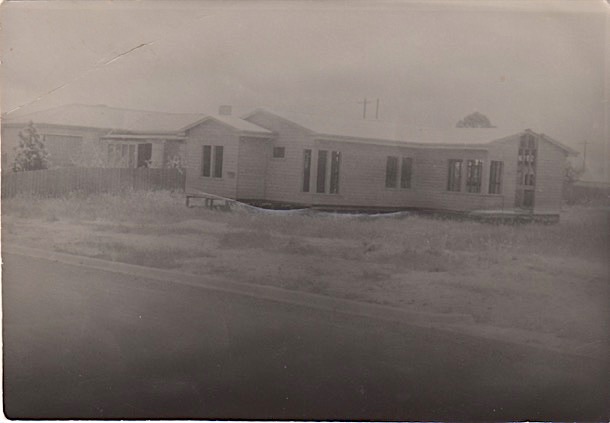
It was a very liveable and rather nice design, set on stumps, weatherboard cladding and with a low slung, pitched roof. It had the standard three bedrooms ,one bathroom, kitchen, dining room, lounge room and laundry. When first built there was an outside toilet attached to the single garage that also had a chook pen attached to it.
Over time, the surrounding paddocks filled with houses and our house changed a little too. The view of the Dandenongs from the french doors in the lounge room disappeared, the toilet moved inside and our grandparents built a flat on the back. The addition of the rumpus room and flat spoilt the spaciousness of the living rooms and the back garden. The old weatherboard garage, toilet and chook pen were removed and a new double garage and new chook pen took the new additions to the back fence.
Little appears to have changed externally to the house since Mum sold it about 1981.
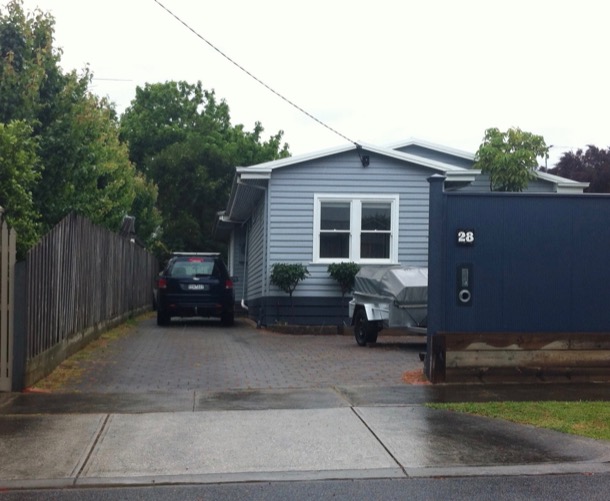
When we were children, Wattle Park itself consisted of large trees with mown grass underneath, like a traditional park, but with native trees and grasses. It was owned and maintained by the Tramways Board, responsible for the tram system in Melbourne. The Tramways brass band played in a rotunda every Sunday in the park. Nowadays those grasses are no longer mown. It looks much more like remnant bushland.
The 137 acres opened as a public park in 1917.
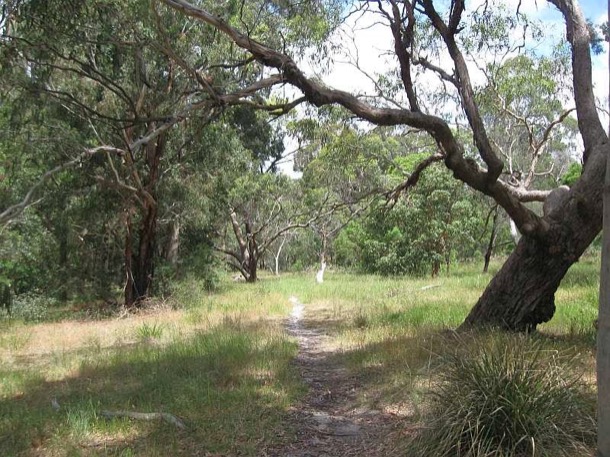
The chalet, designed and built by a Tramways architect, opened in 1928. it was promoted as a dance hall and wedding reception venue and, amazingly, it still is. It is listed on both the Heritage Victoria and National Trust Registers.
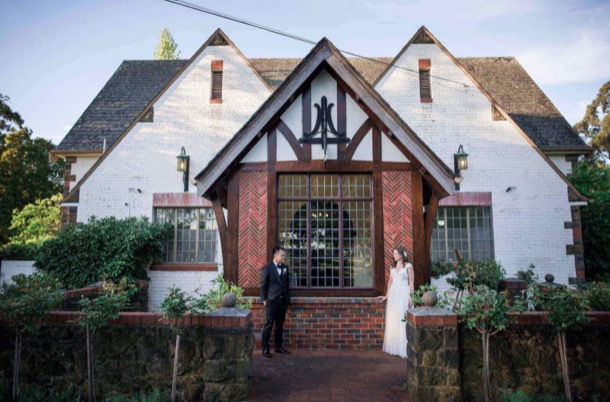
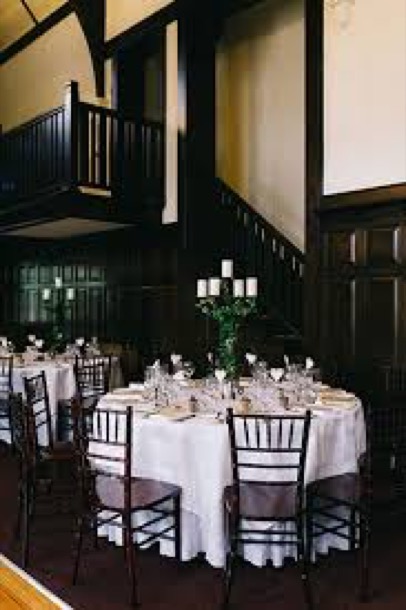
Our own parents’ wedding reception was held there in 1945, after they had been married at the Wyclif Surrey Hills Congregationalist Church in Surrey Hills.
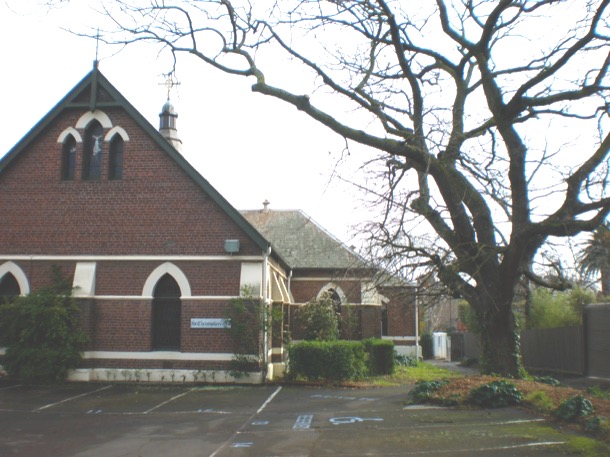
Box Hill Gasworks is now gone, but it was an important part of our parents' history. It was built early in the history of Box Hill:
7/1/1890 The Argus
Some twelve months ago the Nunawading and Boroondara councils granted permission to Mr. Thomas Coates, hydraulic engineer, to lay down gas mains in the streets of the two shires. Mr. Coates purchased an eligible site near Elgar road, Box Hill, upon which to erect the gasometer and the other necessary buildings. At the present time all the mains have been laid down in the shires named, and Mr. Coates is now in a position to light up Surrey Hills and Box Hill with gas. The local works are of such a nature that Mr. Coates contemplates being able to supply the wants of the district for many years to come without enlarging the gasworks. Last night a trial was made in Box Hill and Surrey Hills, when the corporation lamps were lit with gas for the first time. Illumination works were erected at the intersection of the leading streets. The trial was considered a very favourable one, the gas burning bright and clear. In connection with the lighting of these shires with gas a public banquet will be held in Surrey Hills next Monday night.
Over time three gasometers were built.

We don't know exactly when Jim started work at the Box Hill Gasworks, but in 1945 he left the Maribinong Munitions factory, where he had spent the war years. It was that year when our parents married and Jim moved into his in-laws’ Surrey Hills house. Soon after, he started work at the gas works as an analytical chemist. He worked there until began teaching in 1954.
Sue remembers him riding his bicycle to work, and later, a motorbike.
He worked in the laboratory, doing things like checking the calorific value of the gas.
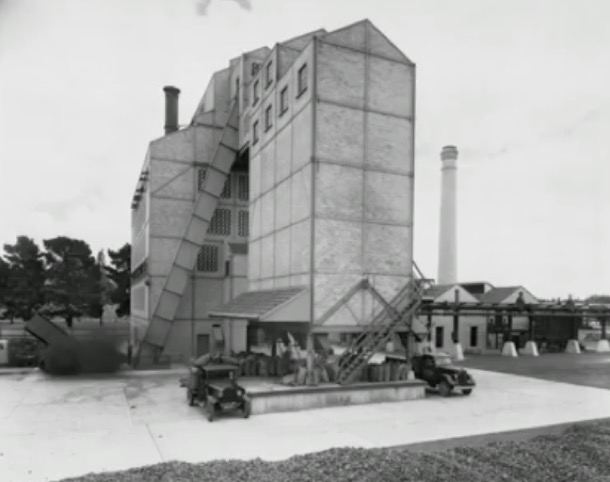

Melbourne’s gas supply was made from Latrobe Valley brown coal, sent by rail to the various gasworks, owned by Colonial Gas Company. Box Hill was one of the biggest. As Melbourne expanded after the war, the demand for gas meant that the various gas works were very busy.
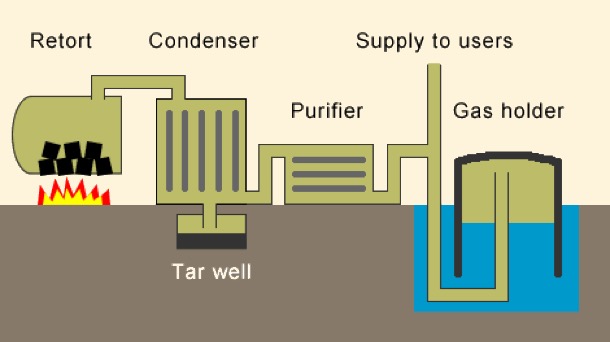
But, by 1960, substantial natural gas reserves had been discovered around Australia. Over the next five years all the Gas plants in Melbourne had closed down, and over 1000 workers were made redundant, by the discovery of natural gas deposit in Bass Strait. Over one million gas appliances in Melbourne were converted to natural gas in 1968. We remember the conversion time. There must have been plenty of publicity. Natural gas has no smell, and, for safety, they put in an additive to make it smell quite strongly. The flame was slightly different, but all the existing burners still worked.
The Gas Works are long gone. Box Hill Institute now occupies the site.
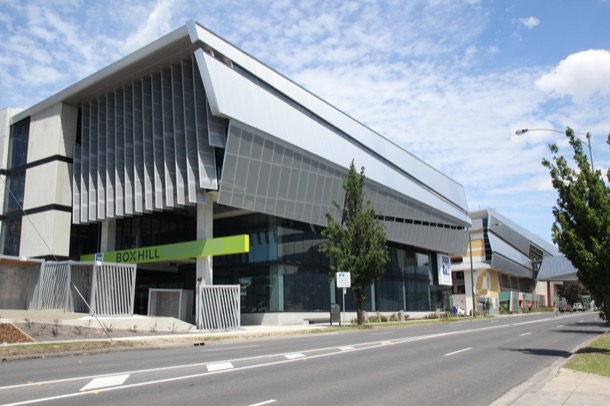
One of the fortnightly highlights in our simple lives was a trip to Box Hill Library. We loved this excursion, as we spent many hours reading on our beds. Books were expensive and we only owned a few. We had to rely on the Library so that we could finish our favourite series like Famous Five and the Billabong Books.It was very exciting if the next book in the series was on the shelf.

This small brick building was opposite the Town Hall at the end of the shopping centre. Whitehorse Road always had a wide, tree lined median strip, as it does today, and the library was right in the middle. It was later replaced by a grand modern library, but the small brick building is still there.
In our childhood, a trip to Box Hill shopping centre was quite an excursion, involving a four mile walk. In 2019 Google Maps says it takes thirty two minutes, but with small legs and a pusher as well, maybe it took a little longer. I remember it was fun and not arduous at all. The route went through suburban streets until Canterbury Road and from there it was ovals and open ground.
Box Hill Brickworks was one of the best sights on the walk to Box Hill, as the brickworks were still in full production. We marvelled at how small the men and carts were at the bottom of the quarry, and watched the procession of carts pass up and down the steep rail track to the actual brick works.
Box Hill Brickworks was founded in 1884 and was one of fifty or so brickworks throughout Melbourne, producing bricks, tiles and pipes for the building boom and ever expanding city. During the working life of the brickworks the clay was extracted from two clay holes or quarries. The first became Surrey Dive which became a popular swimming venue, but off limits to us. Sometimes however, we also gave ourselves the horrors, looking at green, mysterious waters. There were rumours of 'the dive' being bottomless and of swimmers disappearing in its murky depths. One story was of a man who took a very deep dive off the cliff side and simply disappeared. Some time later his body surfaced in Blackburn Lake, five kilometres away. No wonder we looked in awe and horror through the fence.
Today Surrey Dive is an attractive small urban lake used for swimming and remote controlled boat races.. A walking track around the ‘old dive’ and the brick works is planted with indigenous vegetation and a relaxing and attractive area.
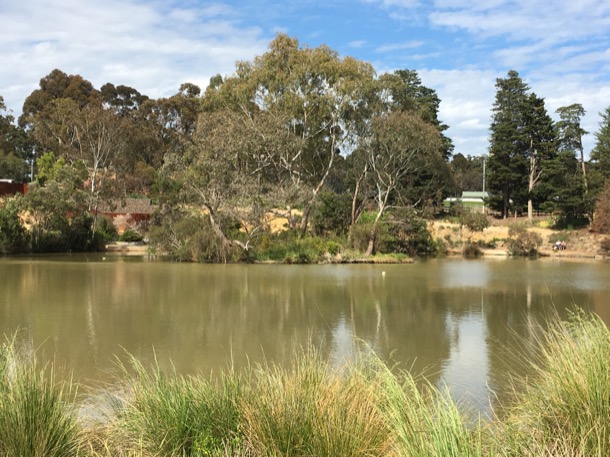
The other clay hole was the quarry that was in operation doing our childhood. It was adjacent to the brickworks and kiln, now derelict but still heritage listed. Unfortunately no restoration work has been carried out. The kiln itself was a massive, red brick building constructed on two levels and, of course, with a huge brick chimney.
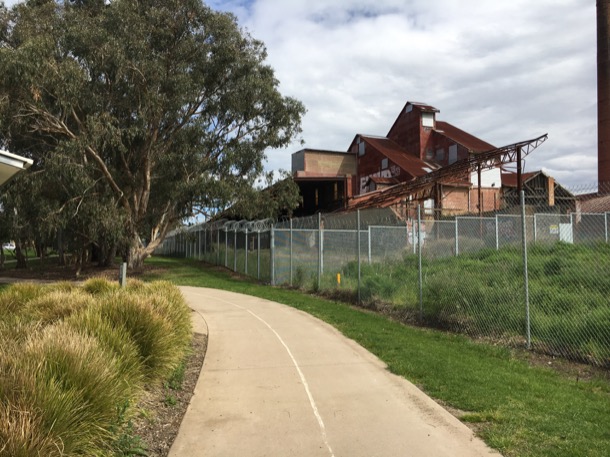
The quarry that was still in full production in our childhood, is now completely filled in. That cavernous hole in the ground is now a large mound covered in every weed known to man. On the horizon above the weeds, are the sky scrapers of twenty-first century Box Hill.
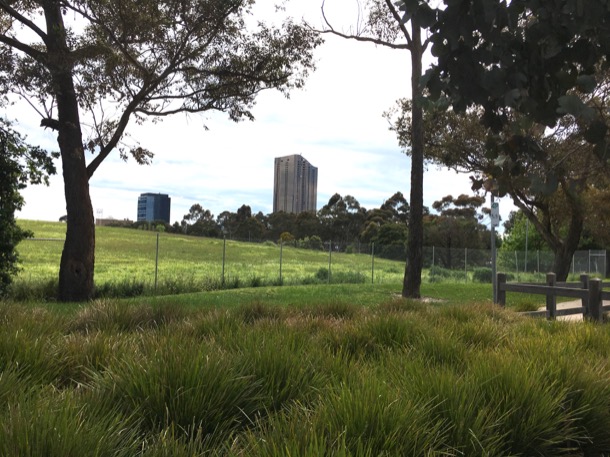
Box Hill shopping centre developed as a commercial centre, as soon as the railway line between Hawthorn and Lilydale was finished in 1862. It became an important transport hub for the eastern suburbs and beyond. During our childhood, Box Hill was the shopping destination for a big purchases. For instance, I can remember choosing a ‘walking’ doll with opening and closing eyes for a birthday present and the excitement of choosing a winter coat with a brown velvet collar. Another favourite shop was the delicatessen where such delicacies as rollmops, sauerkraut and frankfurters could be bought. Amongst the many single fronted small businesses were several large shops such as Taits haberdashery on the corner of Whitehorse Road and Station Street and Maples furniture shop. We also had a Coles variety store that sold anything from socks and singles to cosmetics, and MacEwans Hardware whose slogan was, “You can do it with McEwans because we’ve got a million things.”
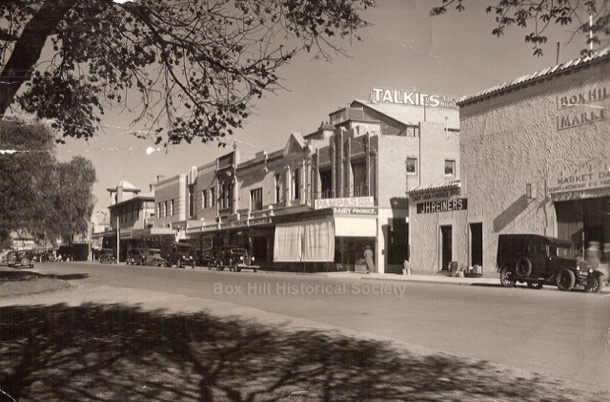
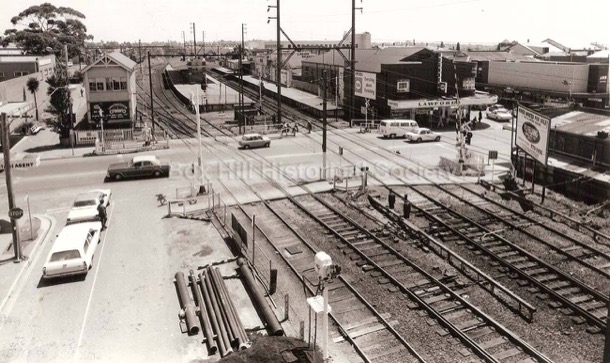
This is a photograph of Box Hill Station and the surrounding shopping precinct in the 1960s. In the centre of the photograph is the old station, that is now underground. Today, above ground, occupying the whole block surrounding the old station, is Box Hill Central and surrounding shopping malls. The signal box, the tall structure on the left of the railway gates is now occupied by the thirty-six storey golden residential tower, called Sky-One.
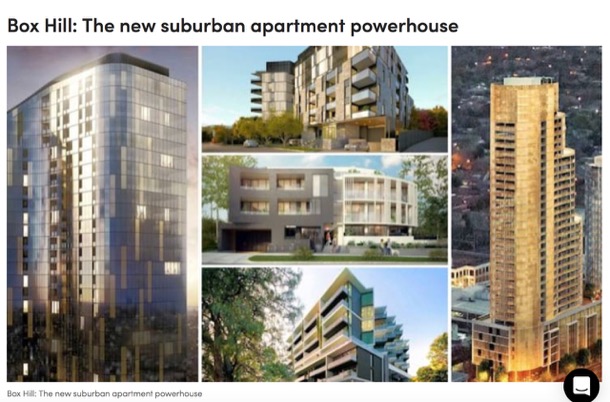
In the twenty-first century, Box Hill, as a commercial centre and transport hub, continues to influence the built environment around it, as you have no doubt witnessed. Officially designated as a development hub, Box Hill now sports high rise office and apartment towers. The streets we once drove down are now shopping malls, the station is underground, the railway gates are long gone and the strip shops have been replaced by a multi storey modern shopping centre. When we were children the shopping crowds were white and Anglo-Saxon. Today they are predominately Asian and the shops and restaurants reflect the change in population.
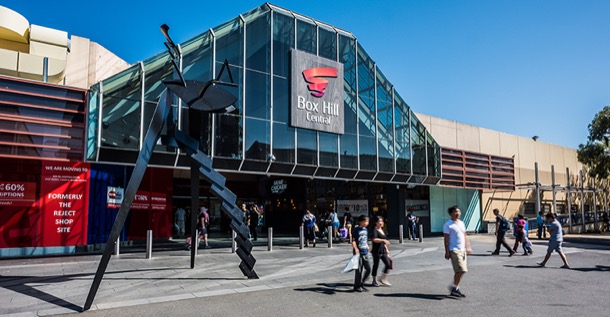
When we, as a family, first started going to the local Presbyterian church, it was called Presbyterian, Wattle Park. We had PWP embroidered on the front of our blue gym uniforms. This was before the advent of the Uniting Church. Church services were held in a cream brick building, called Forsythe Hall.
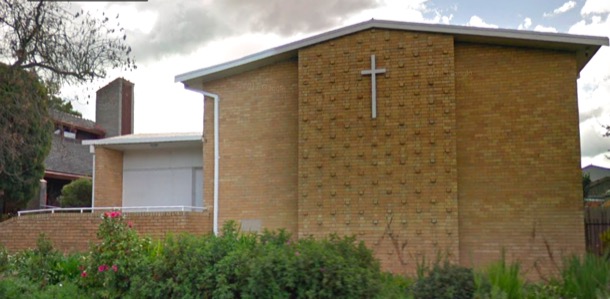
Attached, behind it, was an older little wooden building. During our childhood, this wooden building, Staley Hall, was used for a kindergarten during weekdays. In the evenings, various groups used it, including church boys’ and girls’ clubs (PBA and PGA) and the mixed club (PFA- Presbyterian Fellowship Association), we went to as teenagers. Sue and I both learnt to dance there, and I broke my front teeth on the heater in that room.
We have many memories of Forsyth Hall… dances, performances, Saturday afternoon movies, gym classes and, of course church services.
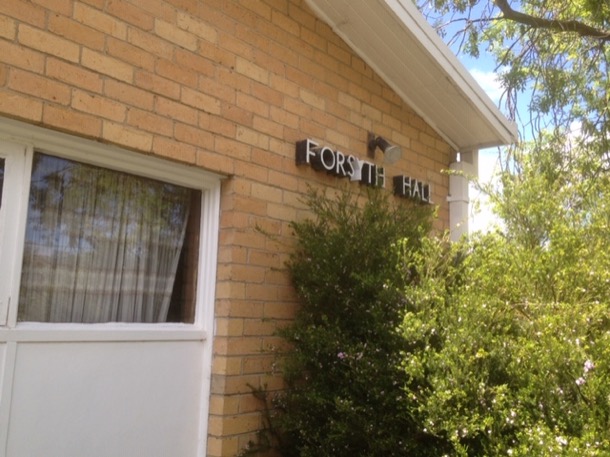
Both our parents were Elders of the church. Our mother taught Sunday School, our father ran the PFA for a while, and was on the board of management. The church was their only real friendship group, and was the only social life we had, as a family.
In the early 1960s the church community began the project of building a new church on the site. The size and scale of the project was a source of much disagreement between our father and others on the management committee.
In the end, a very grand architect designed building was commissioned. The new building was designed by well known architects Chandler & Patrick. An 1887 pipe organ was relocated from a church in Melbourne and extensively rebuilt. The new church, renamed St James, opened in 1965.
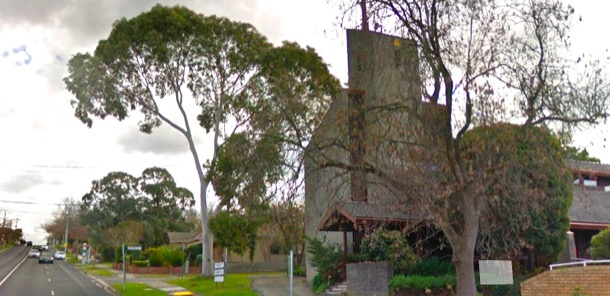
I loved it, because I sang in the church choir, and it had a choir loft at the back and great acoustics.
The buildings are still there. Sue and I visited as a detour on our “back to school” walk in 2016.
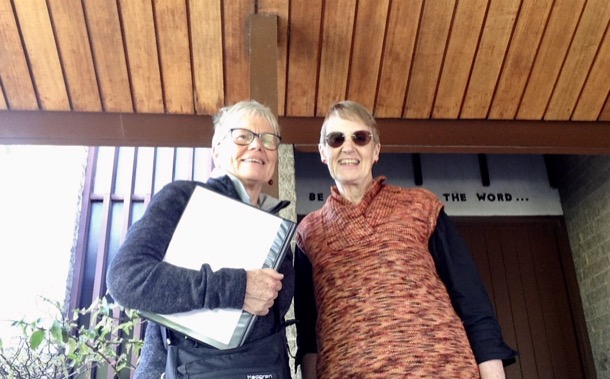
Auntie Bert, a "sterling character"
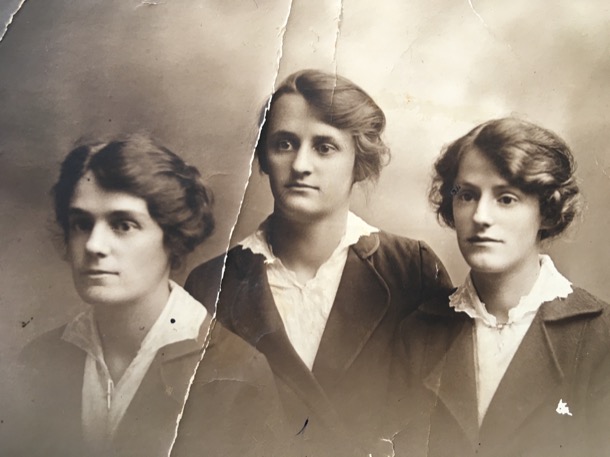
These three young women are our grandmother Alfreda on the left, with her two younger sisters, Beatrice in the middle and Berta on the right.
Alfreda’s set jaw and determined look reflect her independence and demand for an education. I fancy I can see both the rebel and the farmer in Beatrice’s broad face. But look at the gentle, faraway, passive prettiness of Berta. What experiences are already clouding her young face?
About ten percent of the whole of Australia’a population, the country’s young, fit men, set off to war in 1914. More than half of them were killed, gassed, wounded or taken prisoner. There was no such diagnosis as “post traumatic stress”, but we can extrapolate from the modern experience of returning soldiers.
What happened to the equivalent ten percent of young women, who, in different circumstances, would have been marrying them and having their babies?
Our Auntie Bert became one of the many “maiden aunts” of that very specific generation. The family lore is that she “had opportunities” to marry but “chose to stay in the bosom of her family”. We do not know what the reality of her young life was. Had she been a boy, she would have been one of the 417,000 men who enlisted. One would presume that virtually all the young men she might have had a romantic interest in… brothers of her friends, boys from church, at work, on the train, in her neighbourhood… nearly all would have been absent for four years from when she was 18 until she was 22.
Berta Holm was born in 1896. Her childhood and early adult life was spent in St Kilda.
The family story is that Berta and Beatrice unlike their older sister, Alfreda, did not hunger for an education.
Alice and Marge said this in quite a disapproving tone, which made us wonder about the accuracy of the statement, that Auntie Bert left school at Grade 4, declaring that she would prefer to help her mother at home. In Grade 4 she would have been nine or ten!
At the time Victoria was a progressive state and proud to be the first Australian state to create a system of free, secular and compulsory education. This legislation introduced in 1872, required all children aged 6-15 years to attend school unless they had a reasonable excuse. Schools were built, and a system of inspectors employed to enforce compulsory education. Fines for non-attendance were five shillings and increased for further offences. Did Auntie Bert leave school at the tender age of nine or ten? We think it more likely that she attended a State school, maybe unwillingly and, after trying a private school for young ladies, left at the age fifteen. Their disapproval of the lack of enthusiasm for education, compared to their own mother’s, probably colours the story about their aunt. The view of Auntie Bert we were brought up with, was that she was good with her hands, but, to soften and elevate this statement in true Holm fashion, it was followed by, she was a superb craftswoman and much in demand: not academic but exceptional.
Some time after she left school Berta went to work in Flinders Lane.
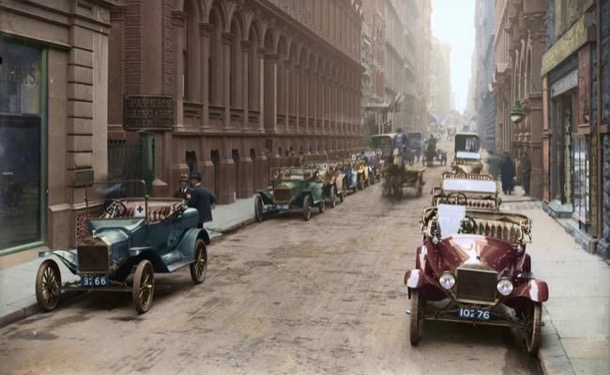
At that time Flinders Lane was the centre of the ‘rag trade’ where many Jewish firms had their businesses. Amongst them was Slutskins, for whom both Berta and Beatrice worked doing ‘white work’. Whitework embroidery is the general term for hand embroidery worked with white threads on white fabrics. It is one of the most elegant and timeless styles of embroidery and was used on underwear, night gowns, table linen, handkerchiefs, baby bonnets, christening gowns and many other small items.

After some experience in this area Berta became forewoman, in charge of a group of other women.
We only have Alice and Marge’s childhood recollections from which to piece together Berta’s life.
In early 1925, when she was twenty-nine, perhaps moving away from her parents’ home for the first time, she left her job, probably that responsible position as forewoman. She went, for an unspecified time, to the country, to help her married sister with a toddler and a baby, and to help serve in her brother in law’s hardware shop.
Alfreda had given birth to Alice, our mother, in 1923. She had had a terrible time, alone, during her first delivery, resulting in the death of the baby. We don't know anything about Marge’s birth or the subsequent few years, except that they were quite near to family help. But when Alice was fifteen months old, Alf and Alfreda moved to Bacchus Marsh. Alfreda was “weak from the birth”. The descriptions of her crying, while scrubbing the floor and having to spend whole days in bed, apparently requiring the help of her unmarried sister, makes us think of post natal depression.
Alf too had what we would today call “mental health issues”. He was a gentle, quite scholarly person, and the business venture in Bacchus Marsh, on the eve of the Great Depression, took a toll on his health. It is no wonder Marge and Alice remember Auntie Bert as a tower of strength and support.
In 1928, the old dry house they had been living in caught fire. At the top of the burning staircase were the little girls in their nighties, Alf sedated, because he was in the midst of a “nervous breakdown”, Alfreda, reportedly trying to find her stockings, and Bert, who carried Alice down the stairs. Marge was carried down by her father, finally awake.
The destitute family were taken in by “the Pierces”. Nell Pierce was a lifelong friend of Auntie Bert. Did they meet there at Bacchus Marsh? We don't know.
The family stayed on for at least a year in Bacchus Marsh, but Berta moved back to Melbourne, once again moving in with her parents, probably her only option.
Now in her early thirties and unmarried Berta must have turned her attention to a job. As far as we know this is when she decided to start her own business as a dressmaker. At first she worked from her bedroom, building her business and reputation.
The business was eventually profitable enough to allow her to move to premises in Riversdale Road, Middle Camberwell and then to Burke Road in Camberwell, just over the junction.
I can remember the junction premises quite vividly. It was one big room on the first floor. Big windows looked out onto Burke Road, letting in light and sunshine that fell on the big work tables. Several dressmakers dummies stood in the corner where the fitting room was screened by curtains. It seemed a very busy place.
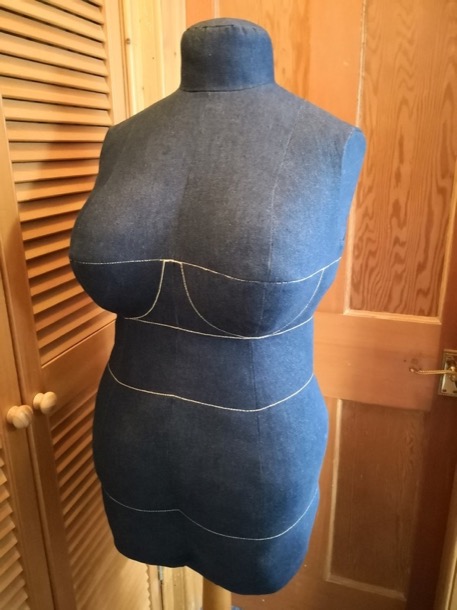

The big tables, that dominated the space were covered in the paraphernalia of dressmaking. There were several sewing machines, many reels of sewing cotton, several pairs of big dressmakers shears, other dressmaking scissors and many tins of pins. Rolls of fabric and garments in various stages of construction took up the rest of the table space. Another woman was sewing at the table, presumably an employee, so business must have been good. We were probably there for a fitting, as Auntie Bert made ‘good clothes’, for Mum. These beautifully tailored clothes were worn to Church and were for special occasions, including weddings:

She also made us beautiful clothes including these woollen dresses:
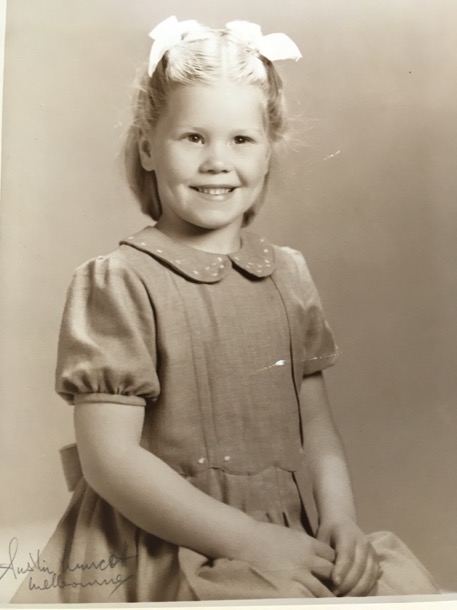
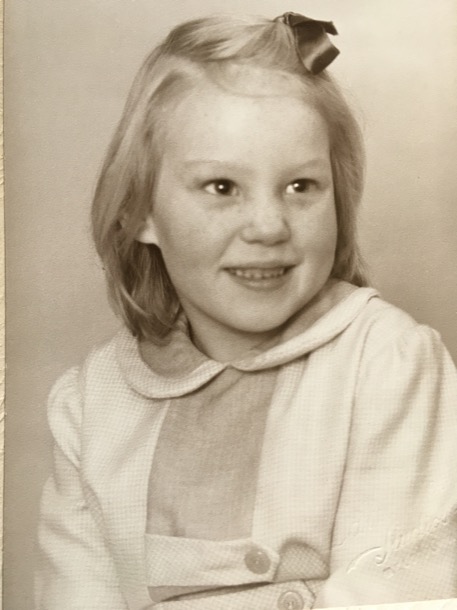
Auntie Bert had an account at Ball & Welch, a prominent department store in Finders Street, Melbourne. She needed an account for her business and a reliable source of good quality fabric for her clients. Its four floors occupied one third of the total block and stretched between Flinders Street and Flinders Lane.
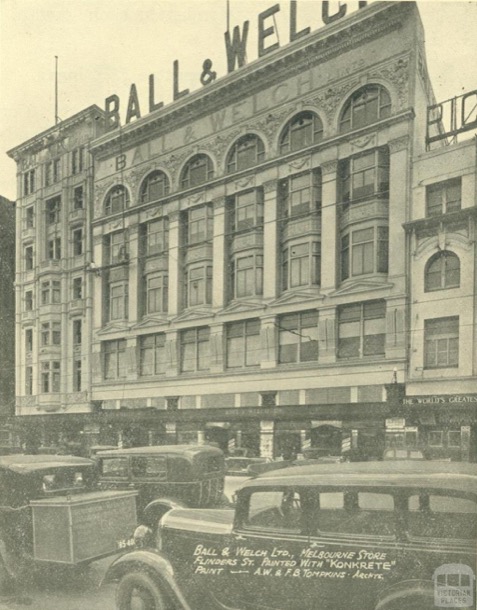
Its many departments included gloves, umbrellas and handkerchiefs, fabrics, furniture, china, millinery, furs and corsets. At one time twenty-six assistants were devoted to the sale of lace alone.
Members of the family were generously given access to Auntie Bert’s account, making it possible to buy items on account and pay later. This was very useful at times, as there was no such thing as Credit Cards. At the end of the month, Auntie Bert sent out letters to all those who had used the account, and we reimbursed her by cheque. This was probably quite a task, not only the arithmetic, but also the sending out of all the individual letters.
I can remember enjoying trips to Ball&Welch. The lifts were staffed by attendants in uniform who recited the list of items available at each level as the lift rose between floors. Parcels were wrapped up in brown paper and string, on huge wooden counters. The expert shop assistants were reserved, formal and a little forbidding to a young child. The exchange of payment was quite a process. The shop assistants' job was to serve the customers, not handle the money. When payment was made, it was placed, with the hand written docket, in a metal canister that went shooting on wires across the departments and then upstairs to the Accounts Department. The docket was checked, change inserted, a receipt written and the canister whizzed back from whence it had come. Transaction complete.
The cash-ball system worked reasonably well, but the rails were intrusive and the interior layout of some stores did not allow certain counters or departments to be connected by inclined tracks. The ingenious Lamson then hit upon the concept of the “aerial railway” and set about tinkering with a gondola-like design, which became known as the wire-line or cable-carrier.
By the late 1880s, sales staff could secure cash inside a small wooden jar or canister, suspended by wheels from a taut wire that ran overhead from the sales desk to the cashier’s station, which was typically a cage-like booth situated in the center of the store. By tugging firmly on a spring-loaded cord or lever known as the “propulsion,” the canister would be catapulted along the wire, reaching its destination in mere seconds.
The cashier could then “return fire” with change and a receipt. Cashiers who worked in booths on levels above the sales floor could simply release the canister and let gravity return it to the appropriate counter.
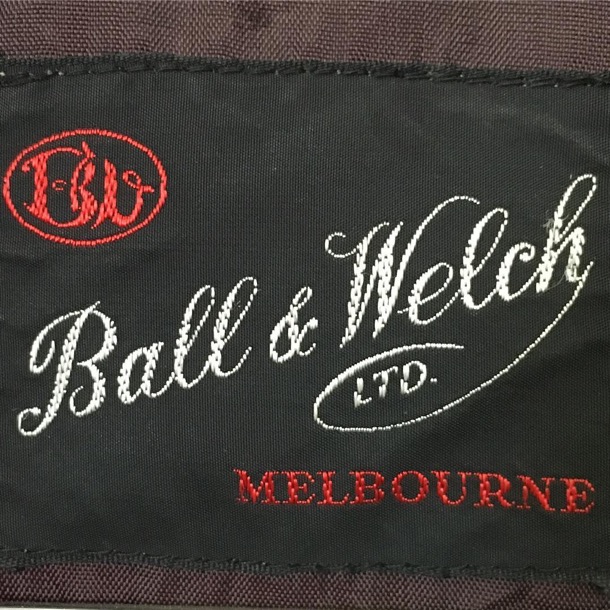
Ball and Welch closed its doors in 1970, the end of an era .
Berta’s sister, Beatrice had taken up dairy farming in the early 1950s, near Cockatoo, in the Dandenong Ranges. The bulk of the work was done by her husband, and three sons. In 1955, the wife of Rob, the middle son, died, leaving a baby daughter, Julie, to be raised by her grandmother.
Into the breach stepped Berta. She moved into a small bedroom in the farm house, and became a second mother to Julie. We remember her room. It had been part of the farmhouse verandah, and the whole room was about twice the size of the single bed. It was neat, sparse and dark.
Our memory of Auntie Bert at the farm is solely inside the farm house. Unlike Auntie Beat, who mucked out the pigs, wearing layers of old jumpers and a woollen beanie, Auntie Bert was always nicely dressed. We remember her in well-cut woollen skirts, stockings and heeled court shoes, with classy jumpers and cardigans. We picture the two of them in the kitchen, both wearing aprons, turning out scones and cakes on the wood stove. Auntie Bert became a permanent and valuable member of the family, looking after the “boys” and Julie.
While her main home and focus was life at the farm, Auntie Bert continued, as she had her whole life, to be the family helper and nurse. She had looked after both her own parents in their final years, and she came to live with us to help out with her elder sister: our Nana, Alfreda, who had dementia. We remember her as a quiet unobtrusive presence in our home. A few years later she came again and helped with Alf, our grandfather, in his final weeks.
So Alice saw first hand, the skill and care of Berta’s nursing:
Apart from staying temporarily with other members of the family, usually to help out during family crises, Berta lived there at the farm, until her death in 1976, aged 80.
Alice reflected on Berta’s death and the simple generous life she lived:
From left to right, Nana, Auntie Bert and Alice: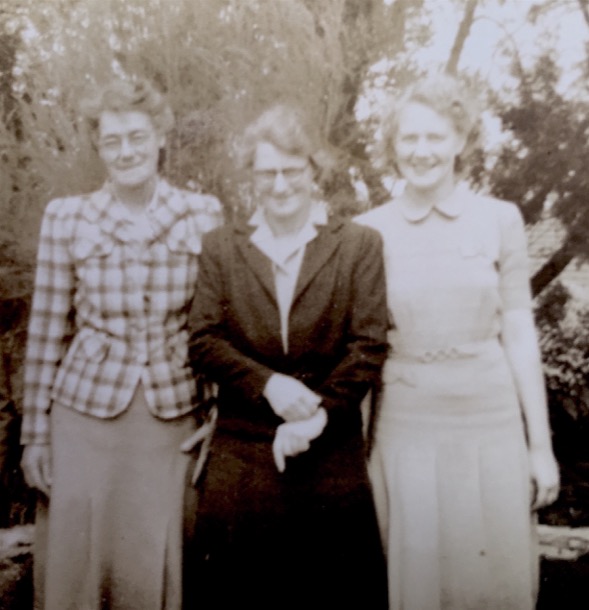
Fred's films
Because he was a photographer/filmmaker, Fred recorded our lives: not the special-occasion-everyone-smile-for-the-camera sort of record, but the everyday. Some of the photographs we have included in various posts have been Fred’s.
And while Sue and I have been talking, writing, blogging about our lives in these posts, so Fred, hunched over a flickering screen, sorting through dusty boxes, has been working through his own story.
So throughout this winter, we have been blessed with little visual gems from our past, some still images like the ones in this post, and others scraps of super 8 film, sometimes just for our own private viewing, and others that will be put together into something more substantial, as Fred works through his archive.
Here then, is just a taste of this rich collection. Over the next while we will put together some more detailed stories of these years.
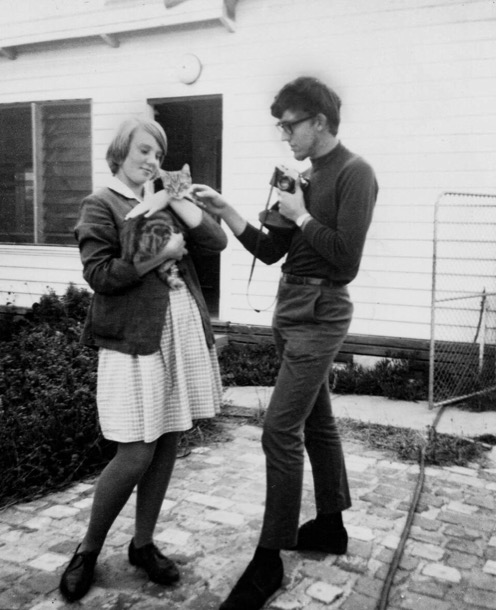
Margaret first met Fred, when he was in second year photography at RMIT and was running the Photography Club at Burwood High School, where Margaret was in Year 10. After Margaret played a part in one of the club’s movies and Fred went to the Year 10 Form Party, Margaret and Fred started ‘going out’. Fred then became an important part of our all of our lives for many years.
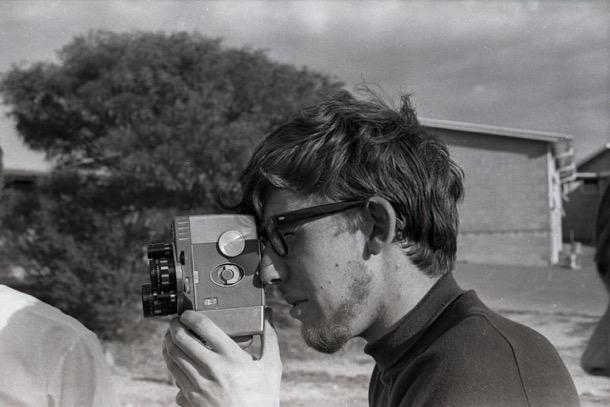
Fred, camera in hand was quite a usual pose in those days, as he recorded the minutia of our daily lives in Super 8 movie film.
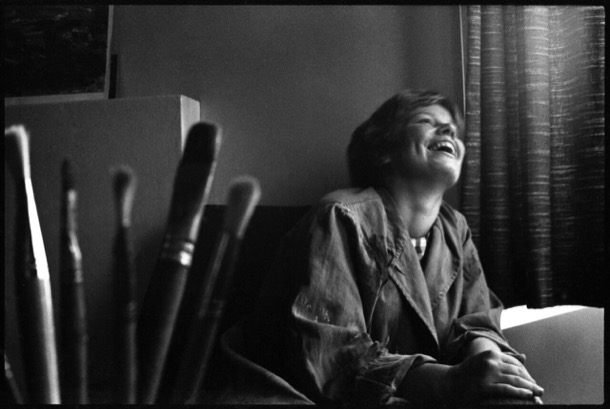
Fred also took many black and white stills with his Pentax SLR.This one is of me in first year of my Art course. I am wearing an old dust coat of Dads to paint in. Teachers in those days, particularly Science teachers, had grey dust coats to wear over their clothes as protection from both chemicals and chalk dust.
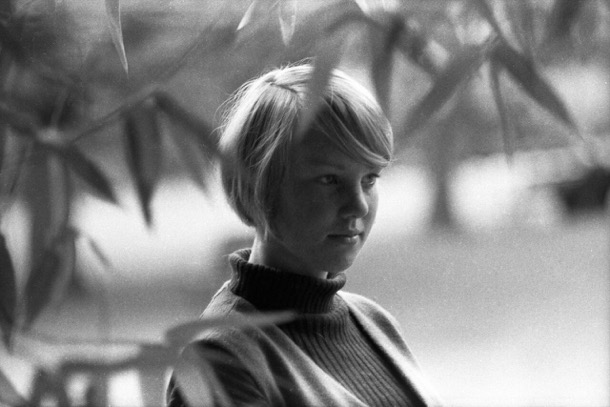
At the Botanical Gardens. Margaret about sixteen years old.
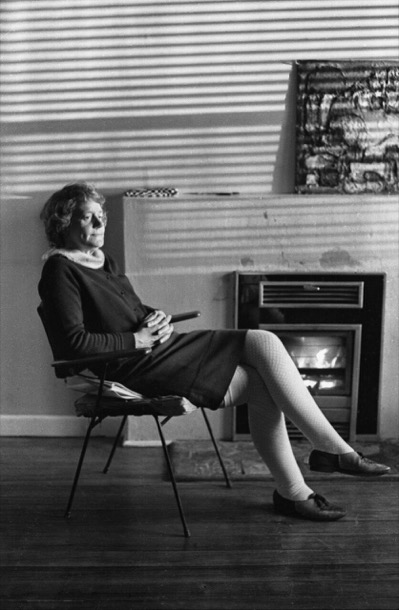
Our mother, Alice, in the lounge room at Moore Street, in about 1967. She was forty-four years old and had recently gone back to work for the first time since she was married in 1945.
When he sent these shots Fred commented, “I like it when you see your parents as young and attractive, virile. These two show a very frugal environment, with the only decoration someone’s school pencil case. If I was photographing her today, I’d automatically retouch that stocking top (and I can if you’d like) but it’s part of the reality of the time.”
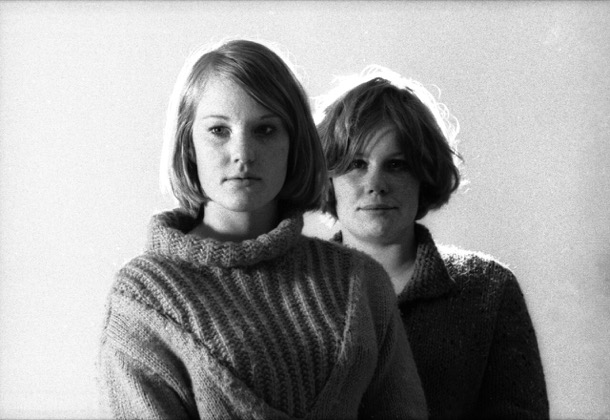
By 1968, Fred was working as a professional photographer. The Studio he shared with two other ex students from the RMIT course, was all set up with special lighting and backdrops. This shot of two sisters was taken there.
Decade by Decade
Here is the audio of this from the recordings:
With our more modern education, we have less of a firm grasp of History, and we know that our children, and their children have, and will have, an even sparser knowledge. So we have taken the overview concept, explained a little more fully, and added in our father’s family history and other aspects we have recently discovered.
Alice and Marge finished recounting their family stories at 1950. One of our tasks in this project has been to continue on from then, and so we have done just that. We explore the nineteen fifties, sixties and seventies, linking what was happening in the wider world into our own lives.
1850-1950
Between 1839 and 1872 our ancestors arrived in Australia.They came from both Northern and Southern Ireland, England, Germany and Denmark. All were from humble origins, having worked as agricultural labourers, domestic servants, a baker and an engineer. Some were already married and others met here.
As our ancestors built their new lives in Victoria, the First Australians had already felt the disastrous impact of European contact. There had been violent conflict, the Wurundjeri population had been decimated and the survivors relocated to reserves or camps a ‘suitable' distance away from the growing population of Melbourne and outlying settlements. In 1844, when the Bourkes took up their selection at Pakenham, they were the first white settlers in the area and the “blacks camp” by the river was noted in Catherine’s memoir. Several years later, Adam Rye, from the other side of the family, was robbed by a party of ’50 blacks’. The newspaper report notes that ‘the blacks at this time were very treacherous’.
With the discovery of gold, in New South Wales and Victoria, there was a huge increase in population and in wealth.
Victoria benefitted the most. Melbourne became Australia’s largest city, with a huge land boom. Grand old buildings like the Melbourne town hall and exhibition buildings are reminders of those glory days.
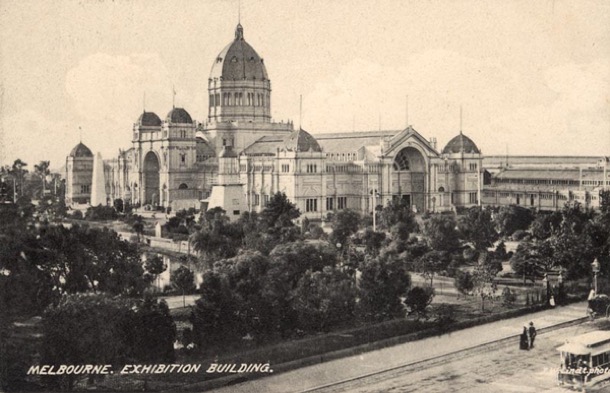
The increase in population, rapid development and the attraction of the goldfields led to a shortage of workers. This meant great job opportunities at every level. It also put workers in a good bargaining position.Trade Unions developed and working conditions were the best in the world. Australia was an egalitarian workers’ paradise.
Small businessmen, like publicans, bakers and lawyers, prospered with the growth in Melbourne. For farmers, it meant bigger markets, more mouths to feed. The growth in country towns, better roads and railway development made life in the country less difficult.
Engineers had a lot of work with the sudden development of infrastructure and property developers were run off their feet. Our grandfather’s grandfather, a young engineer from England, was building bridges in the expanding colony. While building the bridge across the Barwon River, his son, our grandfather’s father, was born, his birth unregistered.
Back in ‘Marvellous Melbourne’ our grandmother’s grandparents who had arrived from Belfast, were developing St Kilda: building large houses and public buildings for those who were prospering in the boom town.
On the land, our maternal ancestor Adam Rye, who had survived the attack by ’50 blacks’, settled in Geelong and worked as a farm labourer. He was later gripped by gold fever and went north to seek his fortune, only to be held up by bushrangers and lose his meagre pickings. His daughter married a German immigrant, Dau, and they settled on a mixed farm at Wandong. Here they raised seventeen children and supplied food to the growing population.
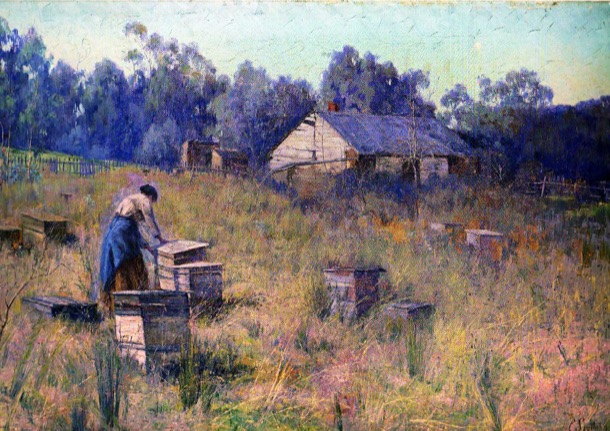
Meanwhile our paternal forbears, also on the land, were making their mark in Gippsland and North Central Victoria. In Pakenham the Irish Bourkes were building their family of thirteen children, and now owned Bourke’s Hotel. They were becoming significant landowners and community members, as they set about acquiring land, marrying their daughters well and establishing their sons on large and prosperous properties. They also served their community in local Government and built the horse racing industry in Pakenham.
1858 Land Sales, Michael Bourke's purchases:
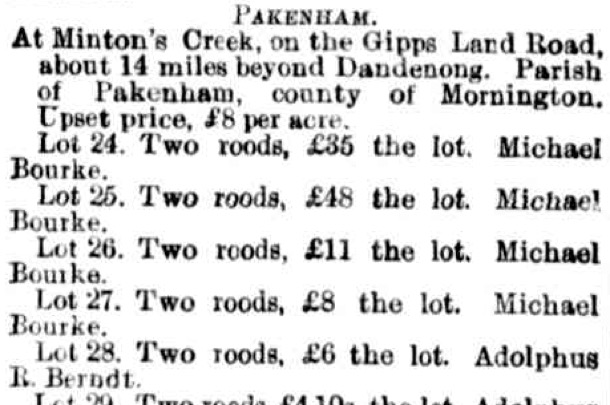
The MacCormacks, in North Central Victoria were also acquiring and working large grazing properties, firstly in Tallarook and then in Molesworth. They too were pillars of the local Catholic Church and community. Our grandmother was born there, at Balham Hill, pictured below.
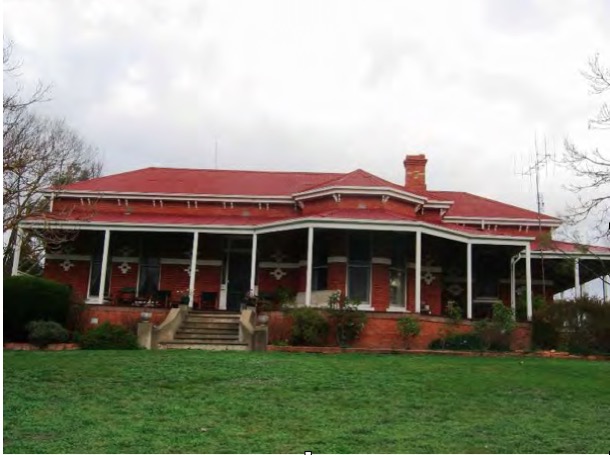
Melbourne became the financial centre of Australia and New Zealand. The Pakenham Bourkes’ fourth son, our great grandfather, was part of this world. He had moved to Parkville and built his law career in this thriving city. Australians were growing in confidence and the young nation was showing signs of an interest in its own identity. This was the era of Henry Lawson and Banjo Patterson, who wrote about the characters of ‘the bush’. At the same time, Tom Roberts and his paintings glorified the unique Australian landscape and the men and women who toiled there. This growing sense of identity and of nationhood is reflected in the moves for independence from Great Britain. During this era of optimism and hope our grandparents were small children, and their families were well established in both country Victoria and Melbourne.
Federation was achieved in 1901, and the country celebrated:
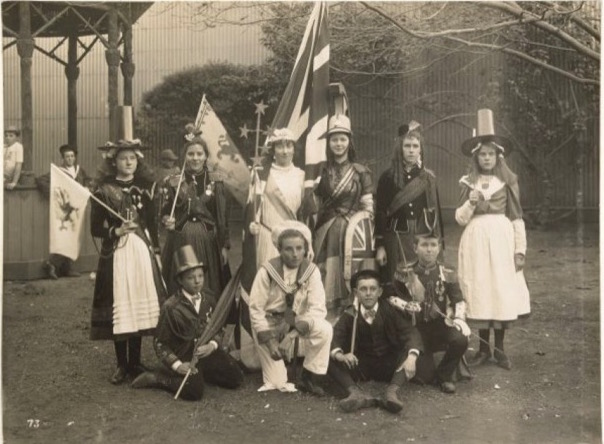
Australia was longer a colony but an independent nation. Melbourne was the largest city in Australia at the time and the second largest city in the Empire (after London). It was fitting that the new Parliament should sit in Melbourne while Canberra was being constructed.
The decade after Federation saw Australian women join the battle for women’s suffrage. White men over 18 in Victoria had had the right to vote since 1858, but women were not granted this right until 1908. Our maternal grandmother, Alfreda, was sixteen when women were granted the right to vote. We imagine she would have approved. She had been engaged in her own battle to pursue her dream of further education; and during this decade she finished her secondary education at Melbourne’s Continuation School, the opening of which marked the beginning of state secondary education in Victoria.
This period of prosperity, optimism, and political and social change ended in the devastation of the Word War 1. We know little of the family’s war service, but three of our maternal grandfather’s uncles served in France, and one lost his life. In the highly charged patriotic atmosphere of the time, and with mounting casualty lists, the war years must have been a difficult time, especially for our grandfather who was considered unfit for service due to ill health. He was deeply upset when given a white feather. Presumably our paternal grandfather being a country doctor, was in a protected occupation.
Our grandparents were all married at the end of this war. Our father’s parents were married in St Patricks Cathedral in a grand affair. Grace and Hugh then settled in Koroit in the Western District, where Hugh was the local doctor.
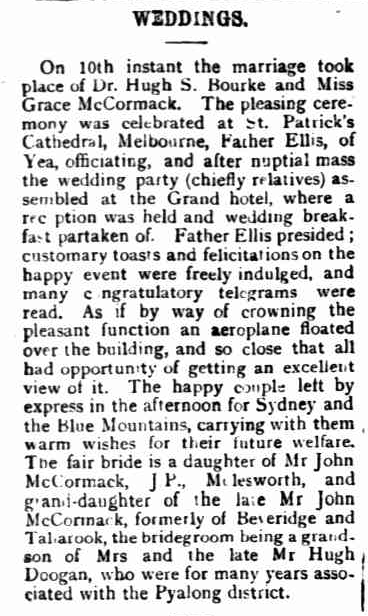
In contrast our mother’s parents were married in the Methodist Church in Surrey Hills in a small and simple ceremony where the bride did not even wear a wedding dress. At that time Alfreda was working as a teacher and Alf was working in a hardware shop in the city. They also moved to the country, soon after: to Eildon, where hardware supplies were needed for the construction of Eildon Weir.
Our family then lived through the Great Depression of the thirties, formative years for our parents who were by then at school. Our father was boarding at Xavier College and our mother was at Croydon Primary School. By the end of the decade the world was at war again.
During the war in a munitions factory, in Maribyrnong, two very different family histories were to merge into one. One was Irish Catholic, successful and quite wealthy, and the other was staunchly Protestant and relatively poor. One was involved in the Melbourne horse racing scene and the other was teetotal and interested in ideas and the new ‘isms’ that were emerging on the other side of the world. Our parents were married at the end of World War 2.
1950s
Our mother’s view of the 1950s, in her recording, is of a time of burgeoning economic growth and development. To us, it is the decade we first became aware of the world.
Our world was redolent with Australiana, but we were intensely aware of our British heritage, and it dominated our reading, our schooling, our whole culture. A portrait of The Queen hung in our school. Sue remembers keeping a scrap book at home of magazine articles about the Royal Family. She was particularly interested in the corgis. Apparently I had one too, and it contained very many pieces about Princess Margaret.
Enid Blyton Books:
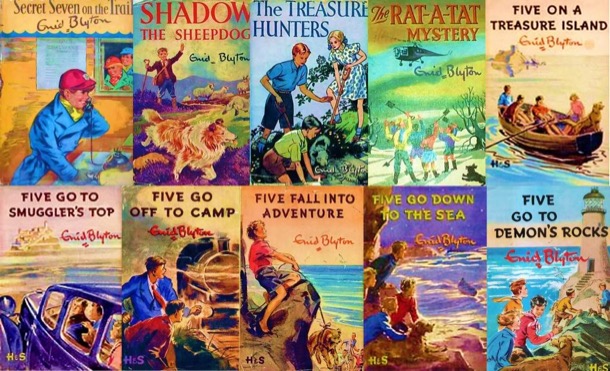
Globally, it was a dangerous world, with the cold war in full swing, and a very real threat of nuclear war. Our parents had quite well developed political opinions, particularly our mother, so we were exposed to adult conversations about the issues of the day. Family friends and neighbours, the Lees, were active in the union movement. They encouraged our parents’ involvement in the movement for “unilateral disarmament” and other left wing activities. I remember our mother’s admiration for an older couple who took a small boat out into the Pacific Ocean to protest the nuclear testing. Bikini Atoll in the Pacific, sixty years on, is still a no go zone from the USA nuclear tests carried out there up until 1958.
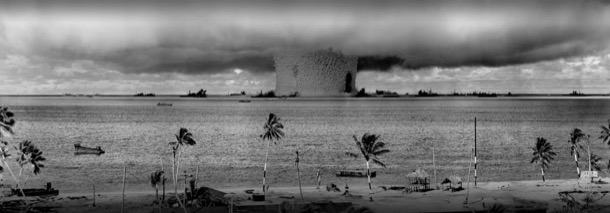
This was the time of McCarthyism in America, and Australian political attempts to ban the Australian Communist Party: a divisive time, where everyday people had strong opinions one way or the other. Sue remembers Prime Minister Menzies as “the devil incarnate”.
The Campaign for Nuclear Disarmament became overwhelmed in the 1960s by anti Vietnam War action, but it was an important political movement of the 1950s. The familiar “Ban the Bomb”, or “Peace” symbol was invented in 1958, as a symbolic representation of ND (Nuclear Disarmament)
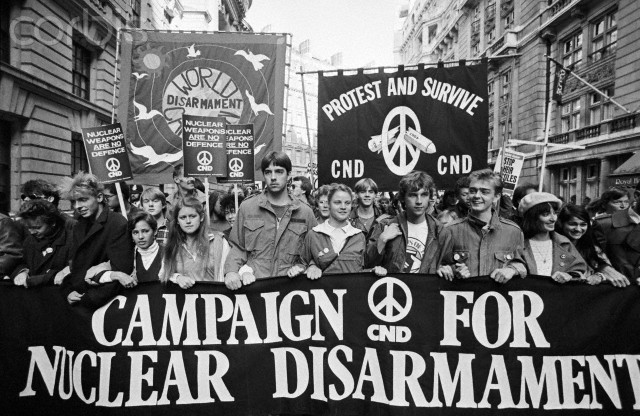
Our family was, by today’s standards, quite poor, but this did not impinge on our life, at this time. We were well fed, we had a stay at home mother who looked after us and the struggle to pay bills was not part of our conscious experience. As far as we children knew, we were neither poorer nor better off than our neighbours, with the exception of the family in the housing commission house nearby, whose son had polio and who didn’t always have enough to eat. The world, as we observed it in our daily life, was largely classless. Perhaps Australia at this time really was the egalitarian workers’ paradise it purported to be, to prospective migrants in Britain. (only whites of course)
Nevertheless, we knew about the religious and economic differences within our family: that our father’s relatives were wealthy and that we were not, because our parents’ union was a “mixed marriage” and very disapproved of. We were very aware of their Catholicism and our Protestantism, and that we were not as close to our grandmother as our cousins were.
Our father during the 1950s, went from working as an industrial chemist by day, and studying by night, to full time teaching. We got our first car, a television and a refrigerator. By the end of the decade there had been four children born. It was busy, but simple life, encumbered by very little “stuff”.
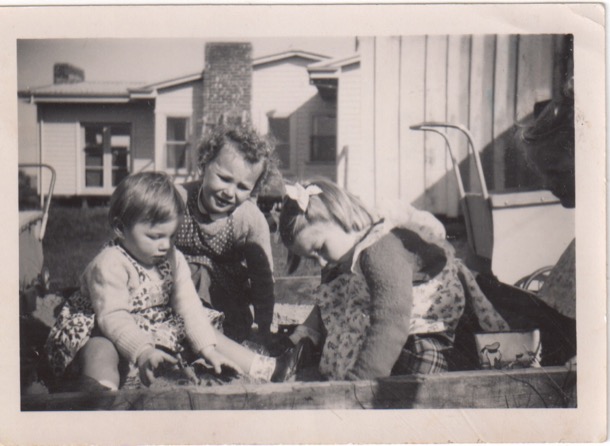
Our suburb of Box Hill South was the edge of suburbia, when our parents first bought their block. During the fifties the new suburbs filled in with more and more families, and the frontier stretched east towards the orchards of Blackburn.
Below is Doncaster, contrasting the 1945 view to that of today. It was little changed in the 1950s. We remember breaking an axle on our Talbot car in Doncaster, a farming and orchards area with narrow unmade roads.
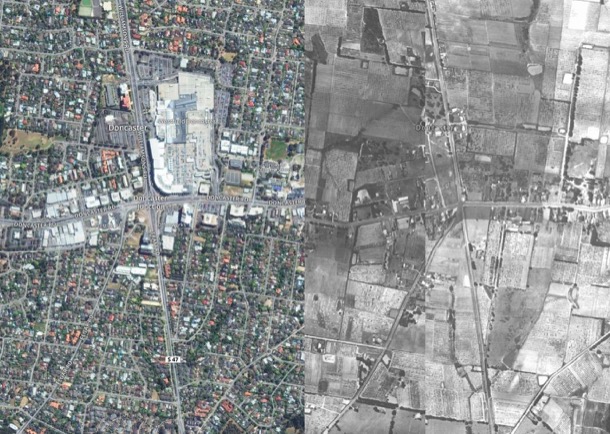
The sewerage reached us during the late fifties. Neighbours got together to dig each others’ trenches. The footpaths were paved, allowing us to roller-skate along them.
The streets were deemed to be safe enough for five year old girls to walk unsupervised, from Box Hill South to Surrey Hills to Sunday School and to Bennettswood to school.
We are baby boomers, and this was the most booming time. When we began school, Sue in 1954 and me in 1957, “temporary” schools were being thrown up, and unqualified teachers recruited to deal with the rush.
My first experience of school was a few weeks in “bubs”, and then the-bursting-at-the-seams class was reduced by a handful of us being put straight into Grade 1. Here is that grade photo with Miss Meadows and her 47 pupils.
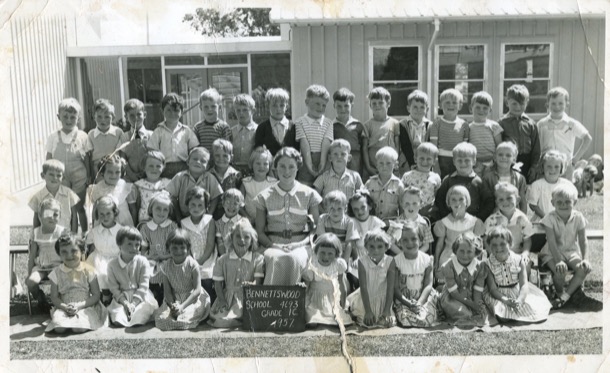
1960s
This decade covers our teenage years. It was a time of huge change in the western world. By the end of the decade, Neil Armstrong had walked on the moon, women were controlling their own fertility with the Pill and popular culture had discovered the huge Baby Boomer teens market. During the sixties, there was a general loosening and questioning of traditional social norms. Older people were probably more aware of these momentous changes. For us the loosening of the cultural apron strings, that is such a feature of these times, coincided with the loosening of our familial apron strings.
The conflict between our generation’s straining at the bit and society’s entrenched traditional values played out in our school life. As fashion hemlines rose, school uniform strictures fought them. We knelt to have the gap between our uniforms and the floor measured precisely, and hastily pulled down our hoiked up dresses whenever a teacher came in sight. The anti war slogans on our pencil cases, alongside the names of pop groups we fancied, had to be kept hidden, or there would be detention. A new rule dividing the grassed hill area into a boys’ side and a girls’ side transformed the hill into a vast empty space with a cramped central area where everybody sat alongside the invisible line. In our school, as far as we can remember, there were no brown faces, hardly any Asian faces and no Aborigines. Foreigners were the Italian and Greek “new Australians”, and even they were rare in our (then) outer Eastern suburb.
Culturally, as more and more families spent more and more time around the television set, American culture rather than English, began to dominate our life.
We can’t remember exactly when we got a television set, just that it was bought specifically for watching cricket. As a family we watched the Australian serial Bellbird, which preceded the seven o'clock news. There were a succession of American sit coms we all watched, like My Favourite Martian, Bewitched, Father Knows Best, the Donna Reed show, Bachelor Father, My Three Sons and Mr Ed. After school I remember Clutch Cargo, Sea Hunt, George Reeves in Superman, and Hogan’s Heroes, F troop and Bonanza. And very rarely we were granted permission to watch 77 Sunset Strip. These are nearly all American titles. There were Australian and English shows too, but it is the American ones we remember.
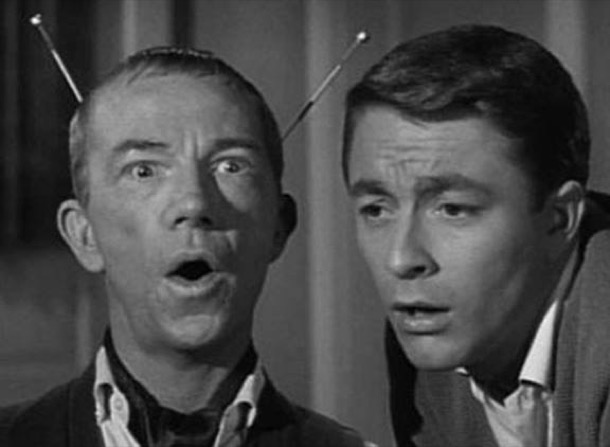
With this American influence in our lives, and increasing prosperity, “teenagers”, a term first heard in the 1950s, emerged even more as a marketing target. For the first time, teenagers had their own music, fashion, language. I was more plugged into Teen culture than Sue. I began to go to local Saturday night church dances from about aged 14. There was always a live band who played rock and roll covers. A group of us from church would go.
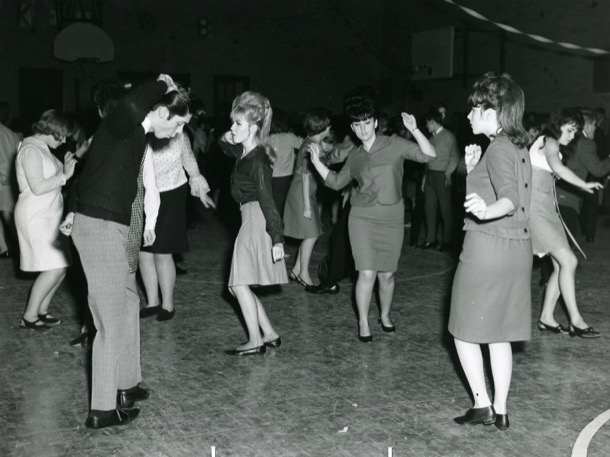
Dress was quite formal, ties for boys and stockings and heels for girls. I remember the winter that plain coloured wool dresses with white crocheted collars and cuffs were all the rage: probably 1965. Auntie Bert, dressmaker to the wealthy ladies of Melbourne, made me a tailored aqua one with little kick pleats around the bottom.
Below is fourteen year old Margaret in the aqua wooden dress with while crocheted collar and cuffs.
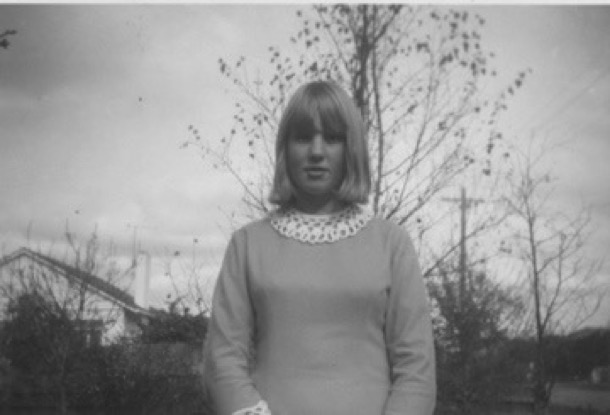
During the 1960s, Australians were entrenched in the divisive Vietnam war. Our family was by default anti war, and the “all the way with LBJ” policy of our government was fiercely criticised. In 1967, my boyfriend and another close family friend was conscripted for military service. Against huge opposition, the government had voted to call up into military service some twenty year old men. Many of them ended up fighting in the jungles of Vietnam. Our mother testified in court for the other friend, who was a registered conscientious objector. But many other friends and acquaintances went off to Vietnam with their hair shaved and very basic training. Some of those veterans live with the trauma of those experiences even today.
A "Save Our Sons" movement protested against conscription:
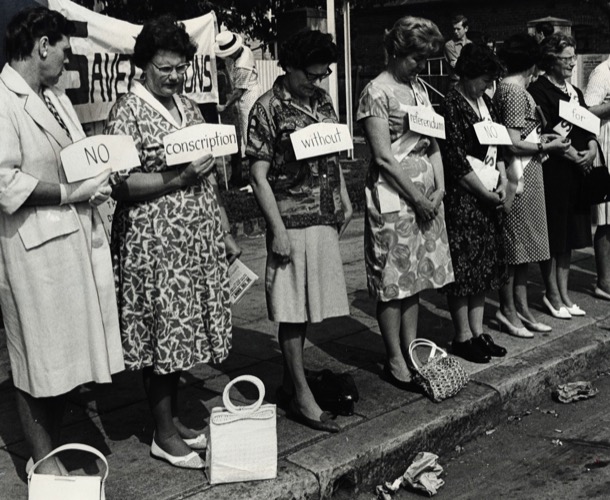
Gradually, public opinion in Australia, as in America, swung firmly against the war; and ordinary Australians demonstrated in the street.
By 1970, Sue and I had left school and were engaged in our tertiary studies, sharing a house in North Balwyn. University was still expensive, and we both managed it by gaining a bonded scholarship called a Studentship, which paid our fees, as well as a small living allowance. Even in a relatively enlightened family like ours, it was made clear that any family budget that was to be spent on university studies, was to be saved for our younger brothers, because they were boys.
1970s
The 1970s was a decade of change for us personally, and a tumultuous time worldwide. In some ways, the decade was a continuation of the 1960s. Women, gays and lesbians and other marginalised people continued their fight for equality, and many Australians joined the world wide protest against the ongoing war in Vietnam. Outrage at the continuing conflict was fuelled by the graphic coverage of the brutality of war, available nightly on our TV screens.
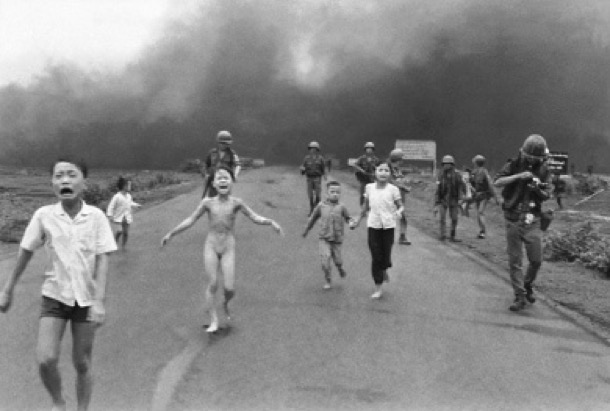
Protest was bitter and violent.
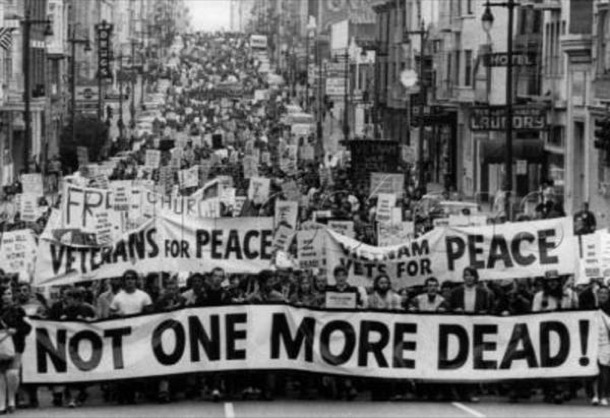
By 1975 Saigon had fallen: a humiliating defeat for the USA.
There was more violence as Pol Pot and the Khmer Rouge murdered 1.7 million Cambodians, and on the other side of the world, the IRA fought for British withdrawal from Northern Ireland.
Rapid advances in technology were in play, changing our world and planting the seeds for the creation of digital world, we are grappling with today. Apple launched the Apple 1, a desk top computer, pocket calculators were commercially available for the first time, and music became mobile with the release of the Sony Walkman.

In the popular music scene, Elvis Presley died, the Beatles split up, the Sex Pistols band recorded an album and disco music took the world by storm.
In Australia, at the beginning of the decade, Gough Whitlam led the Labour Party to victory in the 1972 election. This ended twenty-three years of unbroken Liberal-Country Party Coalition government.
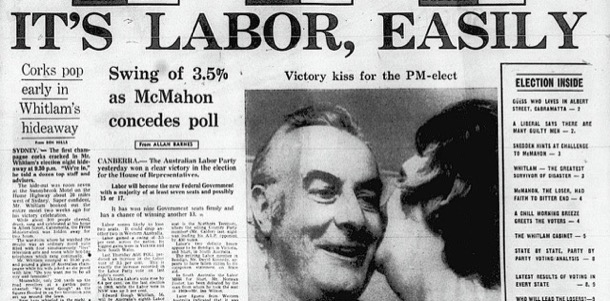
Change was inevitable and rapid: the troops were brought home from Vietnam; educational reforms were introduced, such as free University education; and Whitlam visited the feared red menace, Communist China. Inept financial management, scandal and the rate of change contributed to another landmark event now known as, The Dismissal. Whitlam was sacked by Kerr, then Governor General.
Gough Whitlam stood on the steps of Parliament House and declared “Well may we say ‘God save the Queen’, because nothing will save the Governor- General”:

The Liberals returned to power under Malcolm Fraser. For Labour supporters like us, it was a bitter pill.
Waiting in the wings was Bob Hawke, who was both President of the ACTU and President of the Labour Party. The 1970s ended with Hawke deciding to enter politics. He was elected as the member for Wills in the 1980 election and Labour was once again in power. The 1980s in Australia was Hawke’s and Paul Keating’s decade. The reforms they ushered in changed the face of Australia: we thought for the better.
At the beginning of this tumultuous decade Margaret and I were fancy free. We moved out of home, sharing a house and living on our teaching studentships, as university education was not yet free. Margaret supplemented her income, paid $1 an hour, working at the first fast food outlet in Bourke Street. Working the late shift posed no danger as the Derby closed about 11 pm [very late] and Margaret was able to walk out to her Morris Minor parked right outside the restaurant. “It was always easy to park in Bourke Street, there were lots of parking spots,” remembers Margaret. It was such a different city then. We also embarked on our teaching careers. I began my teaching career in Sale and Margaret at Moe.
We had wonderful camping holidays, often in the Snowy Mountains; we saw interesting alternative movies at the Walhalla picture theatre in Richmond; we went to Sydney on the train to see Hair and saw nudity on stage; so risque! We listened to the Beatles, The Seekers, Cat Stevens and Peter Paul and Mary amongst others, on vinyl of course.
Margaret had begun teaching at Moe in 1973 and Jono and I, after a year overseas, both taught at Drouin High School, quite nearby. By the end of the decade, I had given up teaching and was at home at Gowar Avenue with a three year old Anna. Margaret was teaching at Croydon and was living in Gully Crescent with Ken.
Conclusion.
Marge and Alice finished their oral family history with their weddings and the end of the Second World War. It was neat: 1850-1950. It left off when they were both about thirty, settled into the business of raising children.
We are finishing our own overview at the corresponding stage. For us, this is 1980.
In the very last minute of the recording Alice, by herself for this part of the process, reflects on the speed of technological change that she and Marge had witnessed in their lifetime.
“But there’s a sort of corresponding suddenness in those new technologies and we tremble, as we think you do too, at what the outcome of all this is going to be for your children.
So looking back over that hundred years, we see this period of rapid, strong and significant development: a development that began gently enough, but now, in 1990, is rushed and killing and devastating.
And we look forward into the future for you and for our grandchildren as a time where perhaps you will learn what de-development is all about, and maybe the graph is going to go gently and firmly and calmly for you, into a period that is not as frantic as the one we’ve lived in.”
Strikingly and shockingly, the suddenness and the devastation she speaks of in 1990 has not diminished, but increased. And now, in 2018, as we watch our own grandchildren navigating their way into the world, we too tremble at what the outcome of “all this” will be.
I can hear sleigh bells
Christmas also marked the end of the school year and the beginning of holiday preparations. When we were very young, this involved a wonderful week staying with Pauline, Auntie Marge and Uncle George and later, the huge preparations for camping at Shoreham.
In our minds, Christmas preparations are linked with images of Mum sewing at the kitchen table; cotton ends; bits of material with paper patterns securely pinned to them; standing still to have hems pinned up; and the last minute wrapping of presents amongst the sewing detritus. Dad was packing the trailer and driving to Shoreham to set up the tent. Our parents must have been very busy, but we remember it as a very happy time. Margaret and I remember decorating the tree that was of course a pine tree.
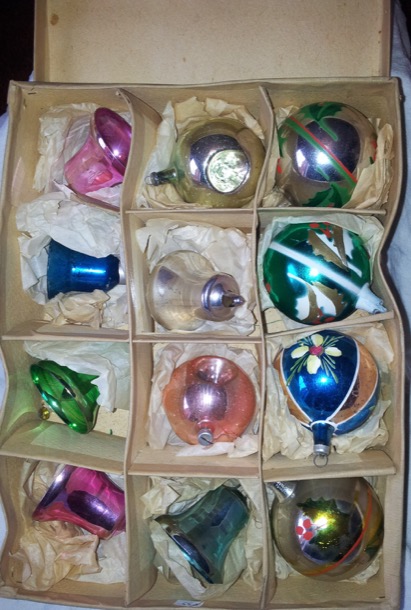
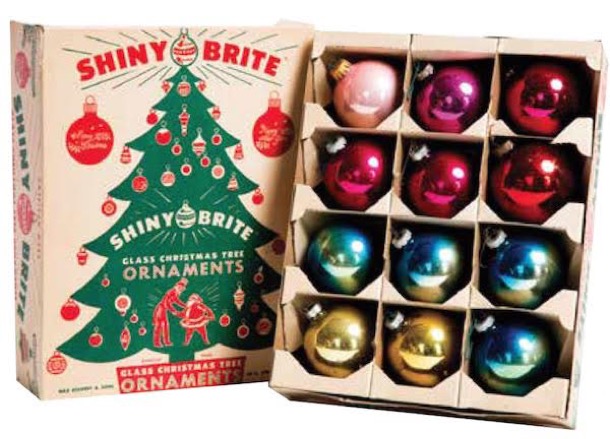
Christmas baubles were made of glass: fragile and expensive.
Choosing the tree was quite a process, as was the decorating, as trees were irregular shapes, not manicured as they are today.
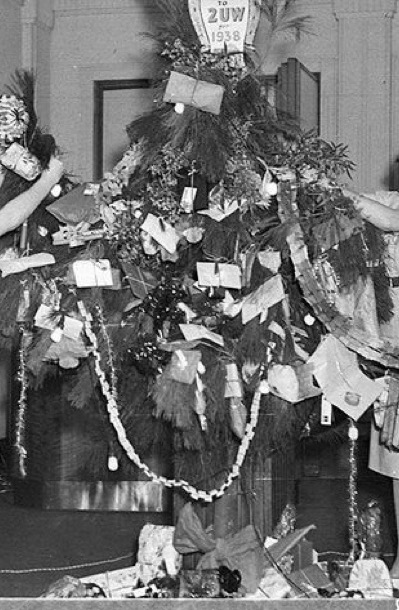
With Mum so busy sewing, it was also easy to slip unnoticed into the dark, tall built-in cupboard in their bedroom, where every year, on the second top shelf, mysterious exciting items in brown paper bags were stored. We remember doing quite a bit of poking and prodding, but never unwrapping and having a real good look. This would have to wait until Christmas morning.
Margaret and I also saved our pocket money for Christmas and bought presents for Aunts, Uncles, Great Aunts and Grandparents. We had wonderful fun in the Coles Emporium in Box Hill choosing the most wonderful pressies.

We choose strong smelling bath salts for Auntie Bert, delightful ornaments for Grandma Bourke, talcum powder for Auntie Tish and often disappointingly, hankies for the men, as they were very hard. The shops, even the department stores, were very, very different. A few Christmas decorations were evident, but shops generally were less cluttered, as there was little if any self service.
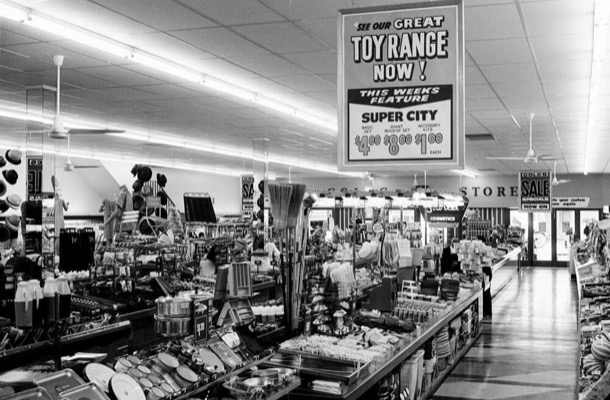

Once purchased and examined we wrapped the presents, made and wrote cards, and either posted or delivered them personally on Christmas Day. Sometimes we also made presents. One year it was calendars. We made them with a prepared calendar printed format and found interesting pictures to paste in for each month. Great fun!
Another delightful memory is of the Salvation Army brass bands who marched the suburban streets before Christmas, stopping every now and again to play three or four carols on a corner. If we were lucky they would stop nearby and we could peer out the window and see them in their uniforms playing the shiny brass instruments. It was always disappointing to hear the tread of feet in unison, as they marched away to the next spot.
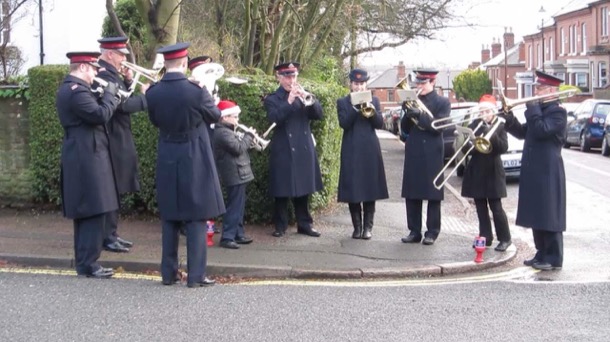
One such very hot night , Christmas Eve actually, the Salvation Army Band had moved on and apparentIy I convinced Margaret that we could hear sleigh bells. Margaret is not sure of it but I am!
I must have been about seven or eight when my suspicions about the identity of Father Christmas were confirmed, although I did still try to deny it and believe for a few years after that. We were staying in a little fibro holiday house in Rosebud with another family. The children were squashed in together in one room, on beds and mattresses on the floor. Late on Christmas Eve, I saw two figures, our parents, laden with crinkly, crunchy pillowcases, stumbling around the crowded room putting the ‘sacks’ on the respective beds. I remember telling Mum that I had seen them, and being cautioned to keep the knowledge to myself. I did!
Christmas Eve for us didn’t involve special preparations or rituals, other than the placing of a pillow slip on the end of each bed. We called these “sacks”. Sue remembers “hearing” Santa’s sleigh bells one year, and sometimes the Salvos street-corner concert would be on this special night, but generally the excitement began on waking.
As soon as I remembered the specialness of this particular morning, I would reach out my toes and touch the lumpy sack that now took up a good ideal of the bottom of the bed. The crinkle of wrapping paper and the solidity of its contents were thrilling. Sue and I shared a room, and the first one awake would wake the other. I guess we woke the two boys too, or perhaps they woke us up.
The ritual was then for each of us to carry our sacks up the hall to our parents’ room and have a mass unwrapping there, on their bed.
When Sue and I talked at length about our reminiscences of our childhood Christmases, one of us raised the question of what presents we remember. The answer is: hardly any. And yet we had very few toys, and only two occasions, Christmas and birthdays, when we got any.
“Stuff” was very expensive and in short supply when we were little. And clearly it was not terribly important in our lives. In our sacks there were one or two intriguing and fairly roughly wrapped parcels. There might be a toy, maybe some “special” clothes, a bag of mixed lollies, chocolate coins, eaten then and there, and little else. One year we were given hard cover bibles, (not very exciting). Later in the day, we presume there were presents from other family members, but we do not remember the actual items, just the excitement of unwrapping and the specialness of the occasion.
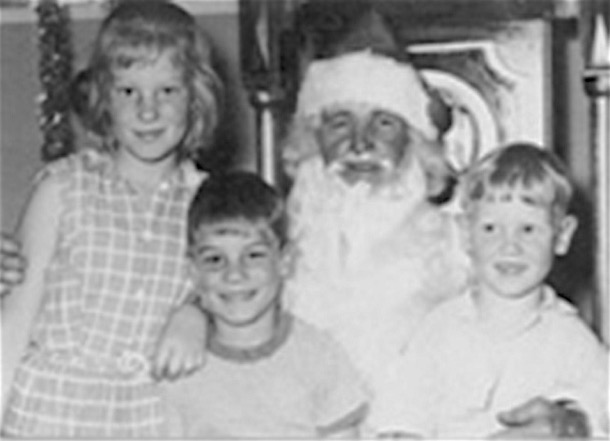
A rare Christmas picture, about 1962. Margaret, Ian and Chris.
One Christmas morning I do clearly remember, was when I woke to find a trail of wool from my sack leading to the large room at the back of the house we called the rumpus room. When I reached the end of it there was a card telling me that my new piano would be placed here. There was a corresponding card on my sack saying that the next year I would start having piano lessons. I had been asking whether I could learn the piano for some time, and, looking back from here, it seems as if I knew that this was going to be very significant in my life.
Other presents we remember which could just as easily have been birthday presents are:
The joint present to all of us of a swing. We got out there early on Christmas morning to use it, and made ourselves sick.
A pogo stick, another joint present.
Roller skates, which attached to our shoes. (Only the boys had bicycles, though we had tricycles when we were really little)
Dolls: mine was black and Sue’s caucasian.
Beach toys, such as bucket and spade, and, later, rubber blow up surf matts.
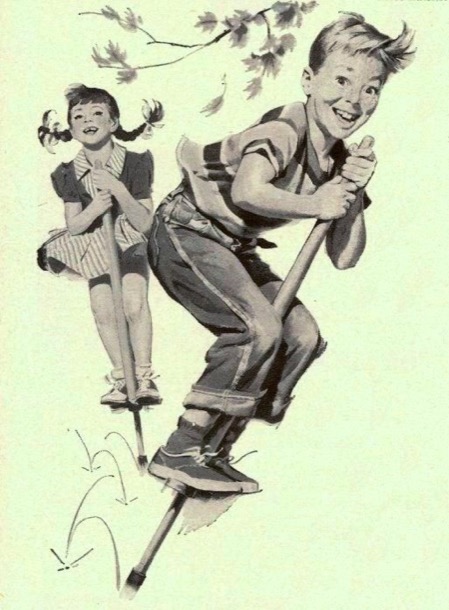
After we had strewn our parents’ bedroom with paper and eaten far too many lollies and chocolates, we had our usual breakfast of cereal, sugar and milk, put on our “best” dresses, socks and either our school shoes, or sandals (we only owned one pair of each) and headed off to church.
Sue remembers the Christmas church service as “a little less boring than usual”. For me, church was all about the music. The Christmas church service was overflowing with once-a-year-Christians and there was an air of excitement among all age groups.
After church there was a small, not very special lunch at home, and our mother doing last minute wrapping of presents for the afternoon. Then, I guess still wearing our best, (although some of us were quite prone to getting extremely dirty extremely quickly), we headed off for the afternoon at Grandma Bourke’s place.
It is about this part of Christmas Day that I have the clearest recollections.
We have written in another post (“Cut out of the Will” 15/6/2016) about our parents’ ”mixed marriage” and the disapproval with which their union was viewed.
Our mother called her mother in law “Mrs Bourke”, which was also her own name of course. We were aware of the tensions between them, and acutely aware of the warmth and familiarity between “Grandma Bourke” and her other grandchildren, who lived in the country and stayed with her every Christmas. They called her “Gannar”.
Presents were exchanged, as we sat in a circle. Interestingly, while we can remember giving presents to the grown ups, Grandma, Auntie Tish and Uncle Matt, we don’t remember any specifics of the presents we were given.
Mostly, for us, these visits were about the food. Afternoon tea, in the front room, stuffed full of dark furniture, was a grand affair. There was a huge silver teapot with its cosy, on a double decker tea trolley with cups and saucers. There was cake, slices and delicious savouries in huge quantities.
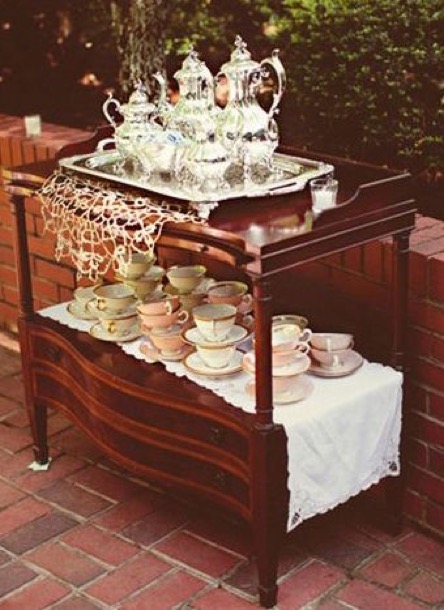
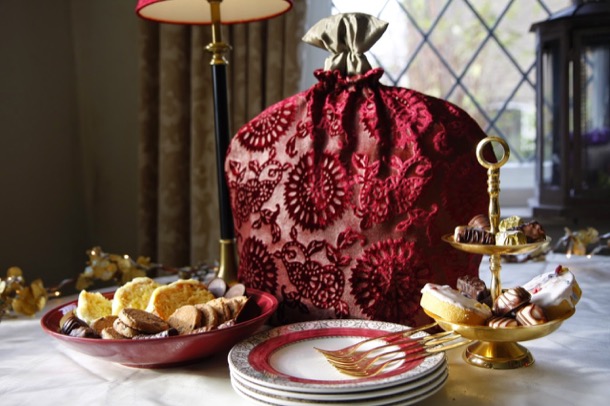
The grownups made conversation, about things that were not of our world: the races, farming the cattle property that Uncle Matt owned in the Western District, television, (Grandma Bourke was a huge fan of Graham Kennedy) and people we didn’t know.
Afterwards we children went outside under the weeping elm tree in the front yard, to play. It is only there I have any memory of interacting with our cousins, and not much there either. They were younger than us, and lived in a very different world. Occasionally our other cousins, Uncle Jack’s children, even less familiar, would come to visit on Christmas Day.
Some years, this was the end of Christmas for us. We went home for a light dinner and woke up to the rest of the holidays, which, in later years, meant six weeks camping at Shoreham.
Sometimes, though, we went on from Grandma Bourke’s in Hawthorn, to Beaumaris and our mother’s sister’s place. After the stiff, tense formality of Grandma Bourke’s, Auntie Marge’s warm welcome and the relaxation of playing with our familiar cousin Pauline, was a huge relief. We would have a wonderful meal and exchange presents lounging around the floor in the spacious living room. There was even a glass of wine (Penfolds Moselle in a flagon) with dinner for some of the adults. Alcoholic drinks did not feature in our parents’ lives.
We did not see our maternal grandparents on Christmas Day. We have no memory of them sharing anything Christmassy with us, even when they were living with us.
Most families have developed Christmas traditions. We remember Christmas as being confined to the day itself and the night before, and we suspect this might have been a common thing in those days. Our family did not entertain. There were never any parties, even family parties. When we look back on this time, and compare it to what kids these days experience as Christmas, it was pretty sparse. Sue and I, reflecting on our childhood Christmases, are aware of, and a bit surprised at, how warmly we remember them.
The Demon Drink
It was clearly uncommon for anyone in our narrow anglo world to drink at home. Here, for instance, is an extract from a Primary school resource book on Temperance from the 1950s.
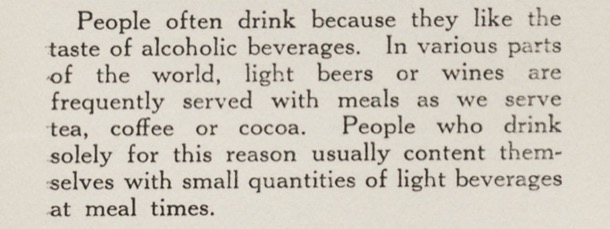
The international Temperance movement was one of the most powerful social movements of the 19th and early 20th centuries. Its advocates regarded alcohol as a social evil and sought to have it banned entirely, or at least its consumption drastically reduced.
Initially it was just a move against drinking spirits and “hard liquor". But during Victorian times it became more a push for total abstinence and became more specifically a women’s movement, connected with Protestant Christianity. Groups of women activists were to be found right across the western world.
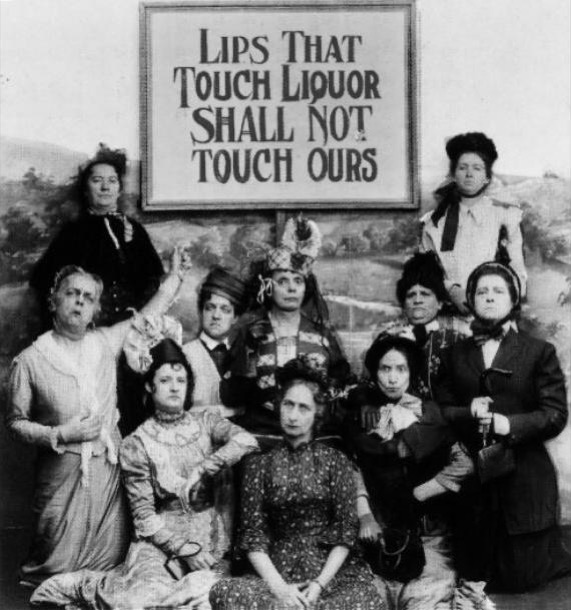
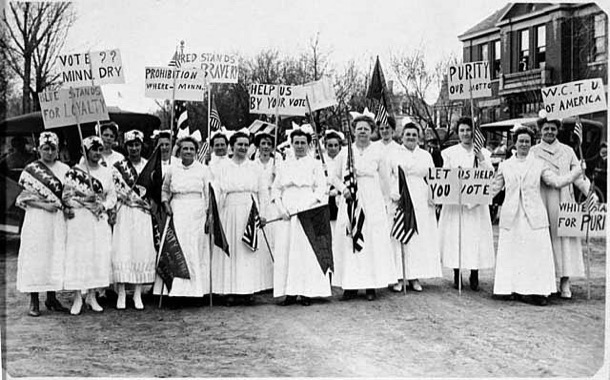
The Temperance movement had its most obvious success in America, where the sale of alcohol became illegal across the whole country overnight in 1920.
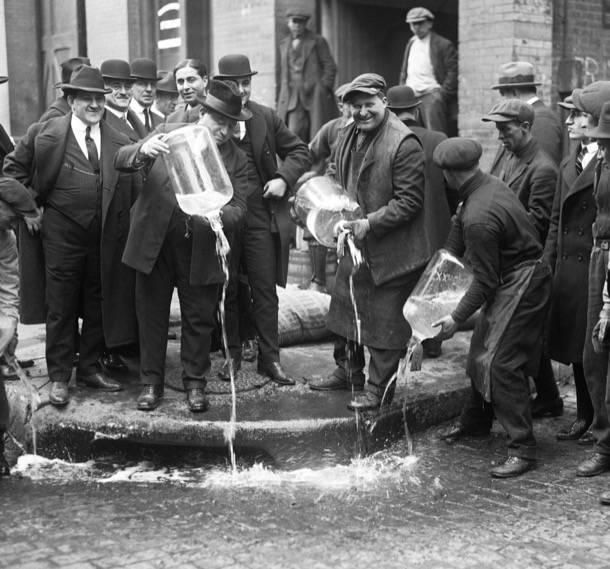
This period of American history has become known as ‘Prohibition”, the Roaring Twenties. It conjures up images of gangsters, speak easies and moonshine. The law did not have the support of much of the population. But it wasn’t until 1933 that it was finally repealed.
In Australia the temperance movement did not succeed in having the ‘demon drink’ banned but it did lobby vigorously for restriction of hotel opening hours. By 1923, hotel opening hours were restricted in all states. The closing of hotels at 6.00 PM led to a phenomenon known as the ‘Six O’clock Swill’.
It is hard to believe looking back that the daily rush to the bar was part of everyday life. Rather than limit drunkenness it actually encouraged it, as men who ‘knocked off’ work at 5 o’clock had only on hour in which to drink. Hotels were set up to serve as many beers as were demanded in this hour. Pubs were overcrowded, as men five or six deep lined the bar waiting to be served and patrons spilled out into the streets.

Pubs did smell strongly of beer as so much was served in such a short time. Sue can remember walking past Young and Jacksons on her way home and pushing her way through the throng of men, spilling out onto the pavement on the corner of Flinders Street and Swanston Street. Men, yes only men! Women were not permitted in the Bar until the early 1960s and for many years after that it was frowned upon. We can remember conversation stopping momentarily when we first walked into a bar particularly in the country.
The Demon Drink indeed! We come from a long line of teetotallers: our great grandfather Reverent Alfred Coates, our great aunt Sister Bessie, our maternal grandparents, Alfred and Alfreda, their siblings and our parents. Our mother’s family, the Coates, being staunchly Methodist, we imagine would have been very sympathetic to the temperance agenda. Here is Alfred, in his Methodist pastor uniform with Emma and their daughter:
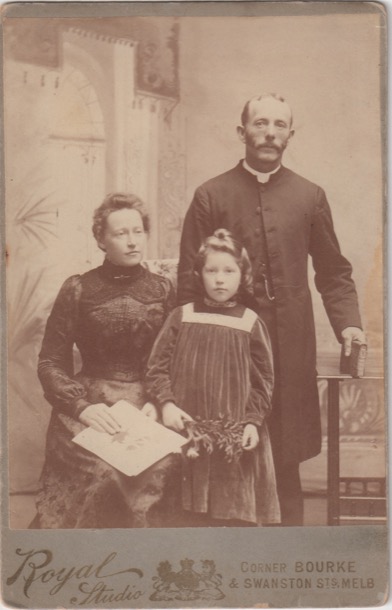
We were very aware as children that none of our family touched alcohol and that particularly frowned on by our rather upright Grandfather.
We too, at the tender age of eleven of twelve, have had our brush with The Independent Order of Rechabites, who provide educational material for Victorian Schools.
Alice and Marge as old ladies recounted their childhood memories of drunkenness, in the country town of Croydon during the 1930s, with obvious disapproval and distaste. Here they discuss the public drunkenness they witnessed at the hotel and wine hall near their house:
I remember our aunt having a glass of beer at the dinner table, when we were staying there as children. I commented on it and I remember being rebuked. Later our mother told me that it was medicinal, that she had found that drinking beer with food helped her digestion. That mum had felt the need to explain it that way, and that our aunt had reacted so strongly to a child’s interest is understandable in the light of heir own childhood experiences and family attitudes.
And then, during our late teens, as the 1960s became the 1970s, this part of our past just melted away. It became normal and natural too open a bottle of wine to share. There was binge drinking around us, especially at Uni parties, and the drink driving hazard was evident, but the moral dimension, the “holier than thou” attitudes, the raised eyebrow were all gone. Society had grown up about the same time that we did.
.
Family camping
Our grandparents and parents had camped as young adults, so living in third world conditions in order to be able to enjoy ‘the bush’ was not a new pastime in our family.
In January 1935, Alf and Alfreda, camping in the bush by the Yellingbow Creek in Woori Yallock, sent letters back to their daughters. In them Alf drew pictures of their camp:

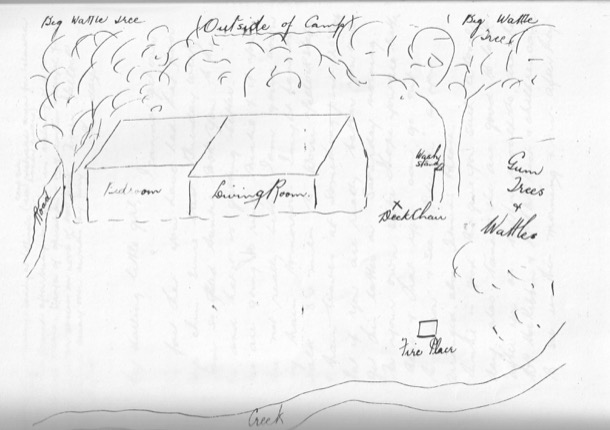
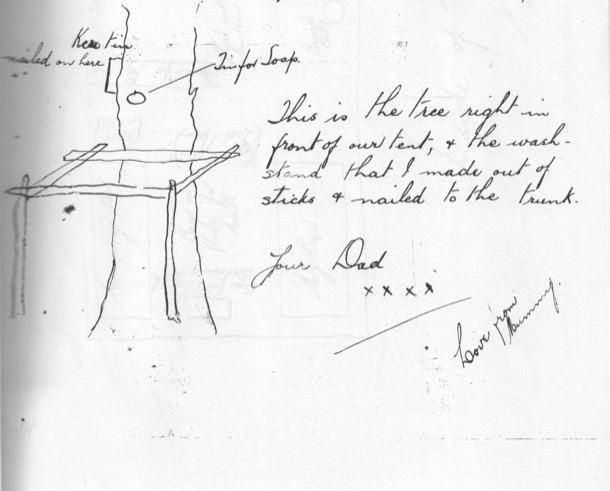
And Alice as an adult, camping with her parents:
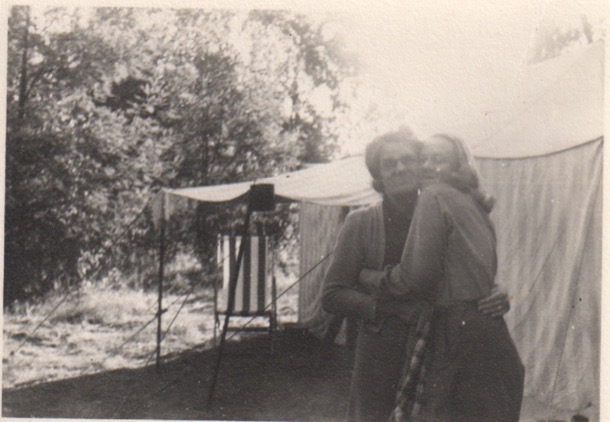
Our parents, Jim and Alice, went camping too:
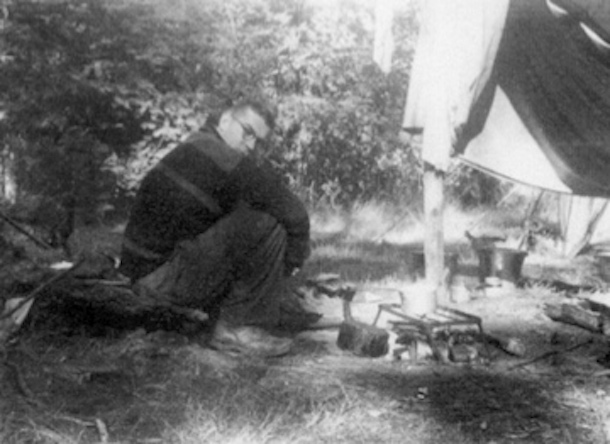
1958 and we kids embarked on our lifetime of camping. It was very exciting. We went to the Prom with the Lees, a family of five who lived at the end our street. We hired a big canvas tent, a simple square and most of the cooking was done outside. I remember this holiday vividly. We all had a wonderful time swimming in the river and the sea and walking. We even all made it to the top of Mt Oberon.

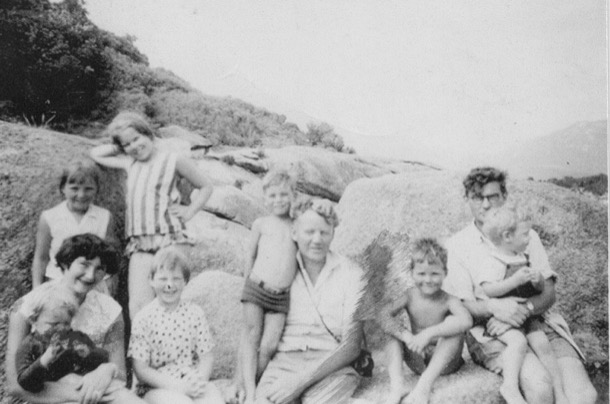
One memorable day there was much preparation for the ‘heat wave’ with temperatures over 100 degrees. Yes, fahrenheit, we are old! A picnic lunch was planned and we waded over the river with supplies for the day. The shady little beach on the other side was the perfect spot for a hot day but i am sure we all managed to get sunburnt. No sunscreen in those days!
That holiday must have been a great success as preparations were made the following year for Christmas holidays to be spent at a new place Mum and Dad had found with the Wilkinsons, a family from the Church. So began the long summer holiday tradition of going to Shoreham.
One of the important purchases that has remained in both our memories was the tent. As we were short of money our parents decided to buy an Army surplus tent. We went to Williamstown to pick it up. In those days driving to Williamstown involved a ride across the mouth of the Yarra on a punt that took a few cars at a time: so interesting that Margaret wrote a Grade 2 Composition on the very subject. Here it as as written:
‘On Sunday we went to hire a tent. It was a very long way. The place we hired the tent from was called Williamstown. On the way we saw many ships and boats. Also we saw a rubbish tip where our Australian rubbish is tiped. When we go there we pressed a button and a man came out. Then we went to buy some icy-poles. When we got back I asked Mummy what a man was doing, Mummy said he was drunk, I said ‘OOOOH’ He herd music playing and wanted to get in. He was knocking and waving then he touched his hat took it off and put it on a man’s knee. Then we had a ride on a queer ferry. which parted from the road.‘
It was a huge heavy old tent, khaki with big black letters and numbers stencilled on the roof. it was rather dark inside and it LEAKED.
Next year Dad’s Uncle Austin died intestate. As he was unmarried, his estate was divided between his relations. The law does not cut people from wills for marrying Protestants so Dad received his share. What a lucky windfall! It enabled us to buy a smart new tent that did not leak and was light and airy
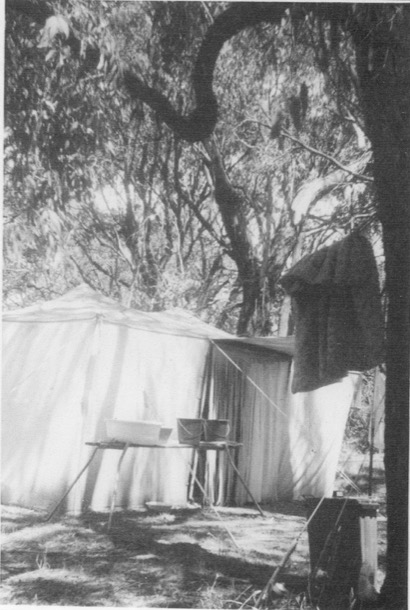
Shoreham Foreshore Camping Ground was on a bushy small promontory on Western Port Bay. It was part of a sleepy small holiday place still surrounded by small farms. There were not a vineyard in sight. The camping sites were well spaced and some were quite secluded. The bookings were done through Mr Webb who was the Ranger and lived in a house abutting the camping area. Water was available in three large water tanks near our site. There were several toilet blocks where, in the morning, a small queue of brunch-coat clad ladies could be seen snaking its way up the hill. Pastel shades and floral prints were the predominant choice of fabric.
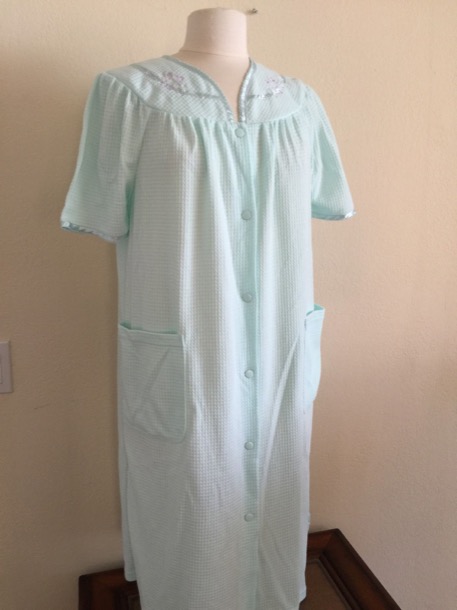
No showers though. Apart from swimming nearly everyday, a bath in the baby’s bath had to suffice.
Our tent was divided into three rooms: two for sleeping, equipped with double bunks, and a general living and kitchen space. We also had a flywire annexe where we had a camping table for meals. The floor, which covered the whole interior, was made from chook food bags we had sewn together on the back lawn. It became quite flat over the years and always smelt pleasantly of chook food pellets.
While Mum was sewing our summer shorts and tops, Dad used to come down a week early and set up camp. It was quite a trailer load and a big job as we had a big wooden chest of drawers, double bunks a two burner gas stove with a griller, chairs, table and an old ice chest. The iceman used to come to the camp ground so we could always keep food cold. In later years we moved onto a gas fridge. A week later we would descend with clothes, food, Christmas presents and a big wooden box of books all ready for a blissful six weeks of beach, shuttlecock, 500, reading and fun.
The book box was quite a feature and sat in the central living space. Dad raided the school library and we all borrowed the maximum from the Box Hill Library. We always had a wonderful collection to choose from. There were often a number of books in series such as A.J. Cronin's series on the life a young doctor in a Welsh mining village in the 1920s and many Who Dunnits. Great absorbing reads that we all looked forward to.
Another of the memorable, nightly rituals was the lighting of the Tilley. Tilleys are kerosene fuelled pressure lights that give out a tremendous amount of white light and therefore were terrific to read by. The lighting ritual was impressive to young eyes as it involved a flaming ‘thing’ that was clapped around the stem of the Tilley. Once the mantle was heated and glowing and the flame had subsided pumping began and we waited with bated breath until the mantle popped and was a light.
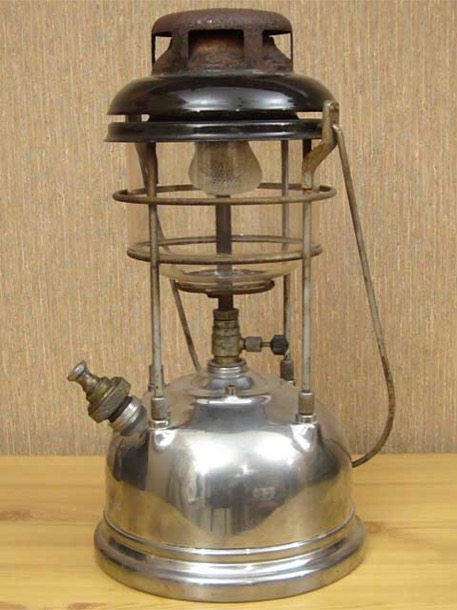
Dinner and washing up would be done and so nightly activities could begin. Often wrapped in rugs we settled down to reading or, more often than not, 500 tournaments. It was great fun.
One wet day game was for Ian and Margaret to embarrass our mother by pretending she was hitting us. We would howl and scream “Pleeeease don’t hit me Mummy! Oh no you’re hurting him!” You get the idea. She would be torn between laughter and horror. Tents have thin walls and we were surrounded by other camping families. Sue even remembers the game extending to shadow play on the tent walls at night. She remembers coming back from the toilets and seeing the acted out scenes of horrific violence. It’s a bit sobering now to consider that some of the “audience” in other tents may well have experienced that violence in their lives for real!
Shoreham has a rocky promontory, exposed at low tide. Then it was too shallow to swim, so we kids spent the time turning over rocks to see the creatures scuttle away, as we walked way out on the rocks. Quite a long way out was “the rock pool”. It was big enough and deep enough to swim in. There was a flat rock at one end which was the “diving board”. The pool was full of waving sea weed, tiny fish, sea horses, anemones. This gave it an exotic, scary atmosphere. Jumping off the diving board and seeing how far we could swim underwater was a favourite game there.
The rocks seemed the same every tide. Year after year we kids clambered roughly over them, caught crabs, and sea urchins, took interesting creatures back to the tent, collected shells.
Sometime over the decades, Shoreham’s bio diversity diminished. There are still crabs, and a few anemones, but the sea horses and sparkly fish are gone.
One year, Ian, aged perhaps seven or eight, turning over one of those rocks, dropped it on his finger. There was lots of blood, huge drama, and a trip to the doctor in Hastings to have it stitched. Sue remembers she and I walking him back to the campground, each of us with an arm around him and Sue with her palm outstretched underneath the finger. She was sure it was about to drop off. I remember feeling very sorry for him because he was not allowed to go in the water for the whole rest of the summer.
Low tide exposed enough flat wet sand for French Cricket. This was organised by the fathers. Everyone played, but we girls really only tolerated it and weren’t very good.
Dad, Ian, Chris and a couple of Wilkinsons:
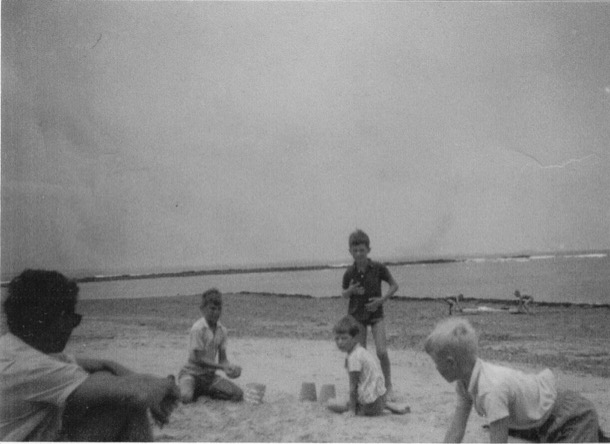
The worst thing about low tide was the sea grass. There were crabs scuttling through its waving fronds and if you swam over it, instead of risking your toes, eventually you felt it on your bare legs and arms and you simply had to stand up.
At high tide Shoreham had wonderful swimming. We would stay in for hours with our poor mother sitting on the beach keeping watch. Sometimes you had to share the water with drifts of dead sea grass, which would pile up in smelly cliffs as the tide went down again.
When our parents could be bothered taking us, we would walk around to the surf beach at Point Leo. Here we could body surf and jump around in the big waves. Later we even had a couple of blow up rubber “boards, like a small lilo with handles. The price you paid for playing in the surf was having to walk back with your bathers full of wet sand. I remember fearing that the wad of sand must have looked as if I’d pooed my pants.
Shoreham beach looking towards Point Leo:
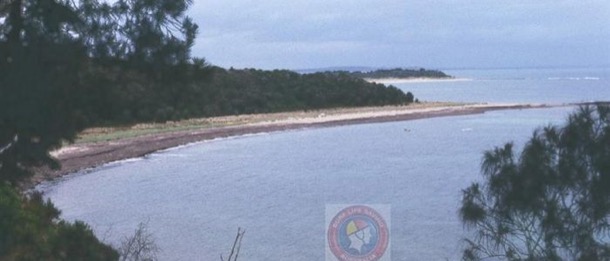
In the other direction was Flinders and the ocean. The view of Flinders from Shoreham was of a long promontory. The Naval Base there used to have gunnery practice, evident to us by puffs of smoke and a distant “whomp whomp”.
Flinders in the far distance:
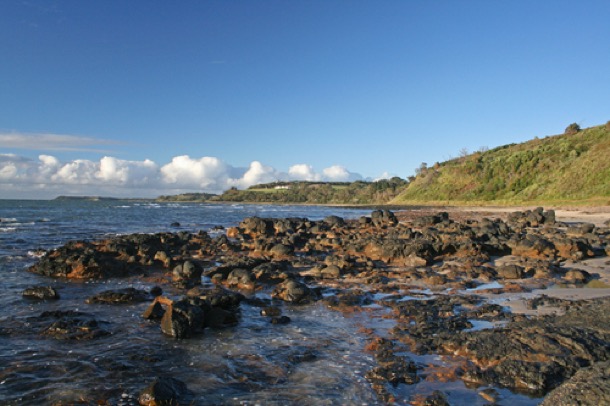
Weekdays involved walking to “the store”. Shoreham had a general store on the edge of the foreshore reserve. Dad and the four kids would walk up along the track, buy The Age, milk and whatever else was needed, even a Drumstick sometimes:

Then we would head along the main road to the Post Office. We took it in turns to go in and ask for “Any letters for Bourke?”. Then we would walk down the post office road to the beach track. Some days we would continue to follow the road past some holidays houses and then rejoin the campground track, but most often we would climb down the steps alongside “Camel’s Hump” and back along the beach. In my memory these steps were steep, treacherous and dangerously slippery. Back at camp Mum would be doing piles of holiday washing all by hand, after lugging the water from the tank and heating it up on the gas stove.
Most years, for one day, usually when it was not beach weather, we would pack a lunch and “walk to Flinders”. Mostly we walked both ways along the beach, making the Flinders pier the turnaround point, but sometimes we came back by the road, and bought fish and chips at the Flinders shop. It was an eight mile round trip, (about thirteen kilometres). The beach between Shoreham and Flinders, mostly deserted and wild, had a succession of small coves and rocky headlands. The first headland, covered in pine trees, separated the camp beach from “Shoreham Proper”.
Walking any distance along the beach included shell collecting. There were lots of interesting and colourful shells but the most prized were the cowries. It was not uncommon for each of us four kids to have twenty in our collection by the end of the summer holiday. We would also collect sea urchins, trapped in amongst the piles of dead sea grass.
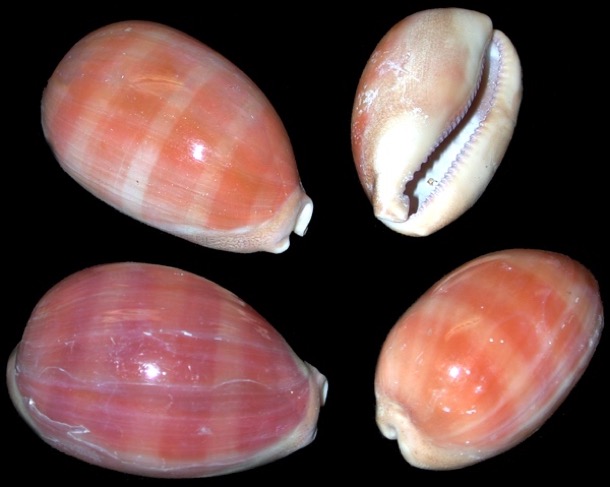
I never understood the pleasures of sun baking, but would spend hours in the water. Our noses were zinc creamed, but not our shoulders. It must have been hard for our mother who was responsible for managing four children’s sun exposure. We were often sunburnt and sometimes even had blisters.
Sue and Mum in the sand dunes:
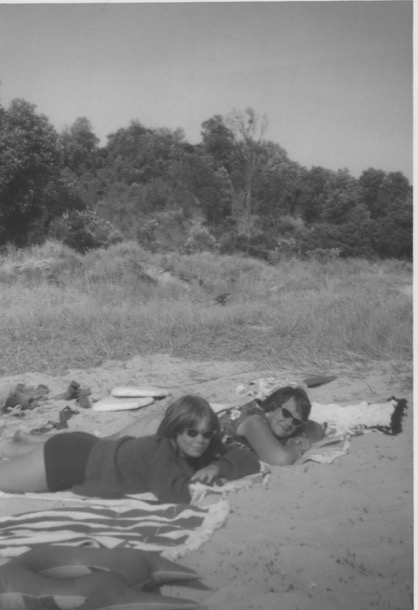
On the six or seven Sundays we were at Shoreham we would dress in the “good” clothes we had brought especially, and shoes (the rest of the time we wore thongs or sandals), and drive to Flinders Presbyterian Church. The Wilkinson family came too. Sue remembers the prickly feeling of a dress on sunburnt back and the resentment of having to go. The church was small and dark and had a small regular congregation. Afterwards we would pile back into the car and race back to the beach.
As the years went on and we went to Shoreham every summer, it became the way I measured the passing years. It was a benchmarking time. The tent set up, the beach, the bush all stayed the same. The people changed gradually, inexorably. Summer holidays was the time to recognise and celebrate this.
This clearly happened for the adults as well. I can remember Alan Wilkinson, chatting to our mother, oblivious of nearby children, the way adults were in those days. “I’m turning forty this year, Al. It’s hard, life’s passing me by.”
By the time I was fourteen I was spending Saturday nights during the year at local church dances. I don’t remember how it came about, but I remember going that summer to a surfer dance at Point Leo Surf Club. This was the time of Little Pattie and Col Joy. Wonderful music in my opinion. I remember a hot, dusty room full of blond suntanned kids, all moving in sync to a band playing covers. The surfy dance was ridiculously simple:

There were always more boys than girls at Shoreham over the summer. Only boys actually surfed. I remember a “date” with a boy who had a car. It was mortifying at first, when my mother insisted that Sue came with us because I was too young, and probably mortifying for her to have to be the chaperone, but I don’t remember where we went, so it can’t have been too bad.
Sue also had romantic episodes at Shoreham. One year she met a fellow camper, who was a Year 12 student doing a navy cadetship. She spent time in Melbourne that summer holidays, doing a “life drawing” course and went out with him over that summer:
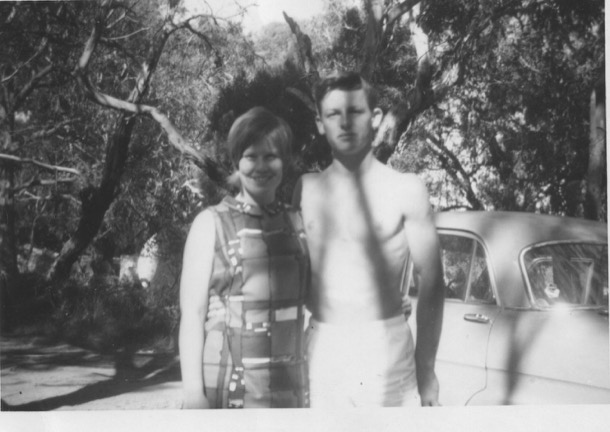
Around the same time Dad and I were involved in a prank at the YMCA camp. Over the summer holidays there were crowds of young boys with older teenagers as camp leaders. I guess Dad might have got talking with the adults at the camp and hatched the plan.
Would I like to be involved? What, you mean walk alone into a room full of a hundred boys having dinner, find the mark, the shyest of the leaders, who has never seen me before, sidle up to him and put my head on his shoulder and snuggle up to him? Try and stop me!
After a few minutes, Dad appeared at the back of the room, brandishing a gun (!) “Where’s my daughter?” he howled.
I don’t remember what happened next, but I have a strong impression of being the only girl surrounded by a crowd of boys and loving it!
Our earlier experience of the YMCA camp was attending the outdoor “pictures”. Campers, each carrying a folding chair, would head off after dinner to the camp and set up facing the strung up bed sheet, amongst all the camp boys.
Shoreham camp was a social place for the adults as well. The same families would camp in the same sites each year, including a few we knew from our real lives. I remember late afternoons on the beach sitting in a group of Bourkes and Wilkinsons, ten kids between us, reluctant to break the spell of the setting sun and then going back to our tent and cooking dinner for fourteen. We had day visitors too, family and friends. I remember Mrs Moss, also a church friend of Mum’s, enormous and perfumed. I remember being impressed after I had complimented her on her dress, when she demurred and pointed out that she didn’t have “her corsets” on.
When the holidays ended we were brown as berries. Packing up was done and then home to the strange sensation of hard floors under our feet and the new school year.
How to Rescue the World
ALF AND ALFREDA
Marge and Alice in their family history tapes, discuss Alfreda’s political and philosophical bent. The setting is Croydon in the 1930s. Croydon is a country town and it is the height of The Great Depression. Alf is working long hours at the Croydon Timber Yard and the family sell milk and cream from their cow. Many of their neighbours are unemployed, and homeless men come to their door to ask for work or food. In Germany, Hitler’s Nazi party is beginning to show its true colours and Russia has been a republic for less than twenty years. Alfreda is consumed by the great ideas of Politics and Economics. She shares this with Frank Hibbert, the Croydon Primary School headmaster.
Alfreda’s friend, Frank Hibbert was a progressive educator who shared her political views. His influence on the young Marge and Alice was profound.
There are also signs of early environmentalism in Alfreda’s letters. On January 16th 1935, she and Alf are camping at Yellingbo, by the creek in what is now the protected area for the Helmeted Honeyeater. She writes to Alice:
Yesterday was a beautiful day and in the evening just after sunset - oh! I wish i could tell you or show you how beautiful the bush was - for half an hour. What God has given us is so beautiful, but don’t humans muck things up - an ugly fence, a cigarette butt, an old piece of lolly paper thrown down. an old pair of shoes - everything we touch seems ugly after that beauty that I saw last night- even our bodies haven’t the beauty and grace of the wild things….. I’ll see we don’t disfigure God’s beautiful bush when we leave this lovely spot.
And later, in 1946, Alf gives us a taste of his own strong sense of social justice. He is visiting Marge in Sydney and has just received the news that Alice and Jim have managed to buy the block of land in Box Hill South that became our family home. He writes:
Your news about your block of land caused quite a lot of excitement in the family circle. Our own few square feet of land is of great importance in our lives. At last we are the possessors of what really amounts to an inheritance - a small portion of God’s earth which we can call our own. It was ordained that each man should have his share of good earth; but man overruled God’s laws and made his own, thereby making it easy enough for a rich man to obtain all the land he wants to, but placing every obstruction in the path of the poor man to obtain that which is morally his own. It is only when people, like you two, scrape to save the wherewithal, that you get your share, or rather, a very small portion of it. But I must keep off my pet theme.
ALICE AND JIM
This was the value system that Alice, our mother, has passed on to us. We were never in any doubt about which side of any particular issue was the correct one.
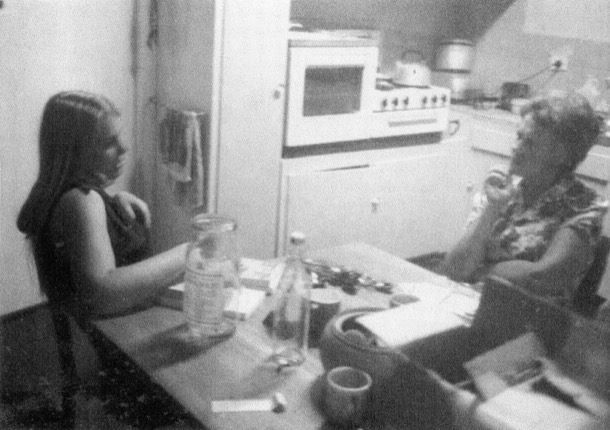
Margaret and Alice at the Moore Street kitchen table
Both Alice and Jim, our father, were staunch Labour voters, and had a strong commitment to social justice.
The world’s first atomic bomb was detonated in Japan in 1945, followed by a nuclear arms race between the USA and the USSR. Bombs were tested, and people felt that there was a constant threat of war breaking out again. Alice and Jim and a like-minded couple from our street were involved in the call for unilateral nuclear disarmament. Another neighbour, Judah Watten, a writer and a communist, was also a member of this “leftist” protest group. This was the time of anti communist McCarthyism in America, and Jim and Alice’s actions were quite radical.
Alice became more confident and able to hold her own in conversations over these years. There were many discussions around our Moore Street kitchen table about the social or political issue of the moment.
Christian social justice became her main focus during her fifties and sixties.
She was active in a number of left wing church organisations. I remember in 1975, when I was living in the country, listening to her talk on the radio about third world poverty. Even in her later years, blind and housebound, she would listen avidly to the radio and talk about politics to anyone who would listen.
Of Jim, we have fewer memories. We remember marching with him in a teachers' protest on the issue of State Aid to private schools. We are now quite used to Governments providing money to private schools, but, when first mooted by the Menzies Government, it was greeted with outrage by many. One of Jim’s concerns during the march was that he would appear on the television news and be seen by his conservative, Catholic, Liberal voting mother.
Jim was a member of the Board of Management of our family’s church, St James, Wattle Park. He was outraged when he discovered the cost of the new church building. He resigned over the issue. In his view the money would have been better spent elsewhere. This is evidence of the strength of his principles, as his role in the church was important to him.
SUE
My memories of my early twenties and engagement in ‘protest’ is of the outrage of youth. ‘How dare they!’
During my last year at College and my first years of teaching, the VSTA, the union representing secondary teachers, was very active in a campaign to improve teaching conditions. I had had an early introduction to strike action by teachers when Margaret and I marched with Dad over state aid to non government schools so I was an eager participant in the ferment.
In outrage that the State Government would contemplate increasing class sizes and teaching allotments, a couple of friends and I formed a VSTA branch and began conducting meetings. I remember calling a strike meeting and organising a boycott of classes that we were convinced would change the world. It didn't! Fancy that! We were still fighting this battle during our first years of teaching.
A much more serious concern was the Vietnam War that the US had been involved in for years and, unbeknown to the public, so had Australia! Prime Minister Menzies had mislead the Parliament and the public, and had committed Special Forces to fight in Vietnam. His successor, Harold Holt, invoking the ANZUS Treaty, upped our level of support and, as the war dragged on with no victory in sight, National Service or conscription was introduced. My family and friends were all very much against the war and the deceptive and high handed action by successive Liberal Governments. Outrage and protest was a consuming passion.
It was sometimes a bit scary! In the early days before the huge moratoriums, the numbers protesting were considerable but not large, and the police seemed to be a threatening and sinister presence. I remember the July 4th 1967 protest outside the American Consulate in St Kilda Road. I went to this one with Mum and Margaret.
It was dark as we arrived and stood with the other protesters outside the closed front gates to the Consulate. There was no visible presence in the building, as we held our anti-war banners and chanted slogans. The most sinister aspect was watching the police buses pull up across the park and disgorge many, many policemen. I remember thinking, ‘Can this be Australia?’ A noisy and highly visible minority of the protesters were quite confrontational and aggressive and were consequently arrested. We stayed well clear of the action but it was hard to avoid the police horses. They are enormous up front and personal, and were used very effectively to nudge the crowd away from the gates. Overall it was a very sobering experience and one that has stayed with me. We live in a democracy with the right to protest peacefully. What must it be like protesting under less benign circumstances?
After these small beginnings the protest numbers swelled, culminating in the euphoria of the Moratorium Marches that brought cities across the world to a standstill, including Melbourne.

The ABC captures the spirit and the times better than I can. Have a look:
http://www.abc.net.au/archives/80days/stories/2012/01/19/3411534.htm
Even though I may have wished for many thousands to take to the streets again, as they did in the Moratoriums, it has not happened on such a scale, but here’s hoping!!
The demonstrations against the Vietnam War left a profound legacy. After such a powerful and successful protest movement, it seems the natural response to feelings of outrage: paint a banner and march! As Margaret says, ‘It is part of democracy’. Aren't we lucky!
Therefore, along with thousands of other concerned people, I have attempted to ban nuclear weapons, stop the war in Iraq, stop logging of old growth forests in Tasmania and East Gippsland and persuade our government to take action to reduce emissions.
The world has changed, but not always for the better. Today, as well as the kitchen table, the letter, the banner and the march, we have at our disposal the power of global and instant communication and social media. It is the era of Get Up and ’Clicktivism’.
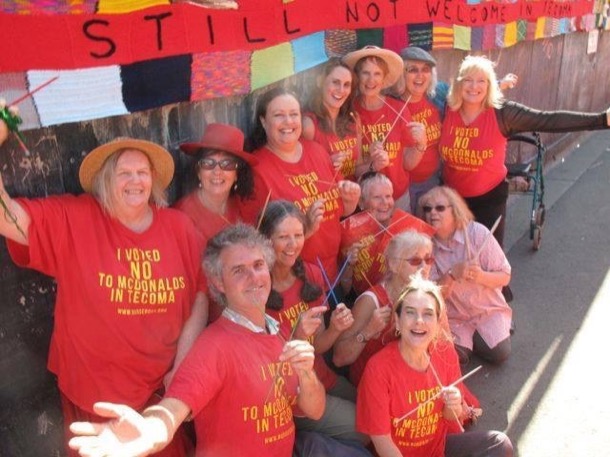
Sue and Margaret protesting together at Tecoma
MARGARET
July 4th 1967. It is winter in Melbourne and it is raining. The puddles flash …blue…black…blue…black…
“Link arms!” call the young bearded marshalls running up and down the line of marchers. We are marching on the American Embassy, protesting atrocities in Vietnam, pressurising our government to change their “All the way with LBJ” policy. Police horses charge the crowd. One of my companions, my forty-three year old mother, loses her handbag.
Five years later a New Yorker I go out with a few times, assures me that there would have been fully armed Marines in the embassy, and that they wouldn’t have hesitated to shoot, had we successfully “stormed” the building.
This was my first real “demo”. I don’t remember why it was just my sister, my mother and I there. I was fifteen.
Over the ensuing fifty years, I have waved banners demanding many things: the end to the logging of old growth forests and the creation of National parks; that uranium be left in the ground; that there be land rights for our indigenous populations; smaller class sizes; a fairer allocation of education funds and more of them; that we not go to war and/or bring our troops home; that the public service not be decimated by cuts; that the separation of power between the judiciary, the legislature and the executive be maintained; that MacDonald’s stay out of our Hills community.
Most recently I marched with Michael and Chris to urge our planet to act on Climate Change:
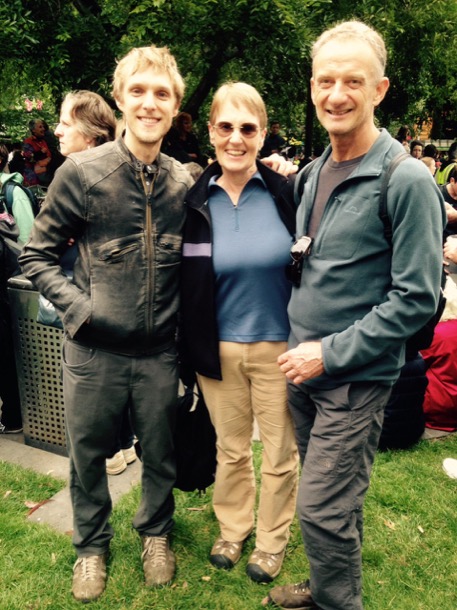
Marching for climate justice... a family affair
The thread that links these causes, is the same thread that runs back to the 1930s around the Coates’ dinner table in Croydon. It involves words like environment, justice, democracy, fairness, equity, peace, kindness and conservation.
Sue, Margaret, Rikki and Fred
Susan:
The 1960s was rather a bleak period in my life. The break up of our parents’ marriage, and the aftermath, had a profound affect on many lives. For me, in the sixties, it robbed me of my adolescence, at time when one should be free to learn, gain confidence and independence and, something always close to my heart, have adventures. This unusual friendship between my sister Margaret, her boyfriend at the time Fred and another girl, Rikki, provided just that, for which I will be forever grateful.
Margaret:
Fred had been called up. He was 19. The marble with his June 5th birthday had been drawn out of the barrel. National servicemen were dying in Vietnam. Glamorous pop star Norma Rowe, whose name had been on my pencil case for a while, was the Nasho poster boy, but the black and white TV screens showed the horror of guerrilla jungle warfare, in the kind of detail that would change the coverage of war for ever. After Vietnam, governments learnt to control the footage and the access. But in Vietnam we saw it all.
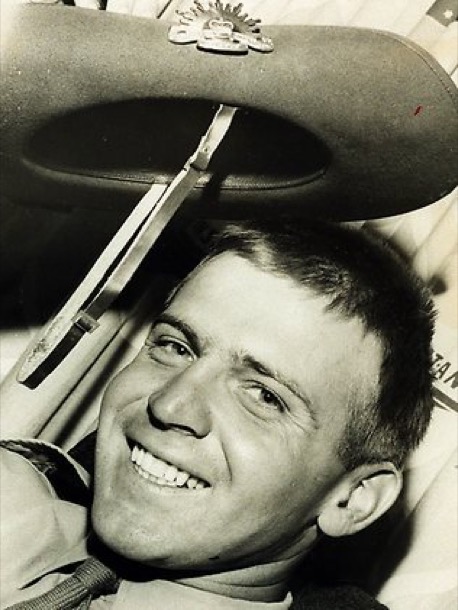
Normie Rowe, conscript.
The Seekers' “If you go away On this summer day Then you might as well Take the sun away….” had been all over the radio that summer. Sixteen and prone to drama, I wallowed in the emotion of my lovely boyfriend being sent to Vietnam.

Fred and Margaret 1967
Fred was sent an appointment for a medical. Luckily he failed the medical and was reprieved. Another family friend who was an offical conscientious objector had to face court, and many went to jail.
Susan:
A breath of fresh air from the outside world came rushing into my life bringing with it new books to read about sea otters in Far North Scotland and Moomins; movies; photography; Carlton; fairy toadstool rings under pine trees at the Basin and above all the magical world of the Australian High Country. Rikki had an interest in the romance of the High Country, as she loved Elyne Mitchell’s books, one of which is the classic The Silver Brumby, a favourite of children of our era. Other books written by Elyne Mitchell are also based in the High Country and tell of her early married life to Tom Mitchell who had grown up in the area.
They lived on his beautiful family property with a view of the Main Range. Here they pioneered the skiing in this area, getting to the tops by horse and pack horse and then walking up a steep ridge from Geehi carrying their skis. We too were captivated by this world.
Rikki corresponded regularly with Elyne Mitchell, who, as you can imagine, was a fascinating woman. Fred also had a connection to this area, as he had spent his childhood and adolescence near Corryong. I had been through the Snowy Mountains on a school trip and was intrigued by this new world. We were all hooked, and thus began the adventures in the mountains.
I will never forget the excitement and thrill of discovery of that first trip in Easter, 1968. We set off up the Hume on Thursday night in the car our father very kindly lent us. A little after midnight, as we drove between Tallangatta and Corryong, we were telling the current scary story of a man on the roof of the car with a severed head. It was especially scary when we stopped to have a sleep in a bus shelter by the side of the road, too tired to go on. At least we had the sense to stop, even if it was freezing, especially sleeping on a concrete floor.
We were so naive and badly equipped for our trip. We camped at Khancoban , all sleeping in the same tent, bizarre, but we only had one, and then drove up to Seaman’s Hut on the Kosciusko Road and walked across to Albina Hut.
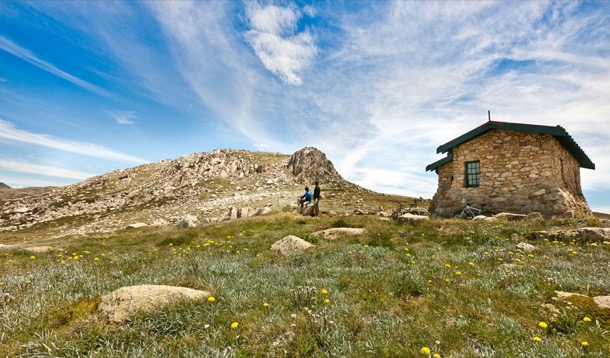
Seaman's hut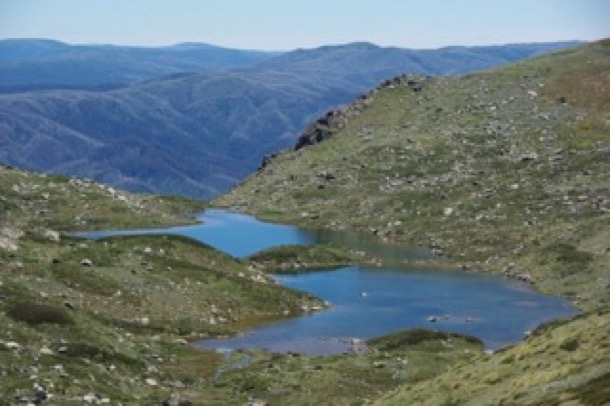
Lake Albina, viewed from Albina hut
Fred, in front of Albina hut, this time with a pack.
Albina Hut is in a beautiful glacial valley just below Mt Townsend, which is only nineteen metres lower than Kosciusko. Dangerous country to walk in with no tent, no proper mountain clothes and no previous experience. Fred even carried a suitcase and an umbrella!!!! What a sight we must have been to the seasoned mountain walkers who were also staying in this hut that belonged to the Geehi Ski Club. I don’t remember anyone commenting or even warning us about the rapid weather changes.
It was fabulous. Loved every minute of the walk: the snow grass, the flowers the stunning granite tors and luckily the cobalt blue sky. My love affair with grasses began here, as did my joy of walking in the mountains.

Sue and Fred in the Snowy Mountains
Margaret:
Around that time Rikki, Sue and I moved in together to the flat at the back of our parents’ house. We ate with the rest of the family, but it was a taste of independence. Sue was studying Art teaching in the city, Rikki was working full time, Fred was in his final year of Photography at RMIT and I was in my final year of school. Somehow through that year, in between weekends away and nights at the movies or out to dinner, I managed to snatch enough study time, but only just. I squirrelled myself away in Mum’s bedroom for the last couple of weeks before the exams.
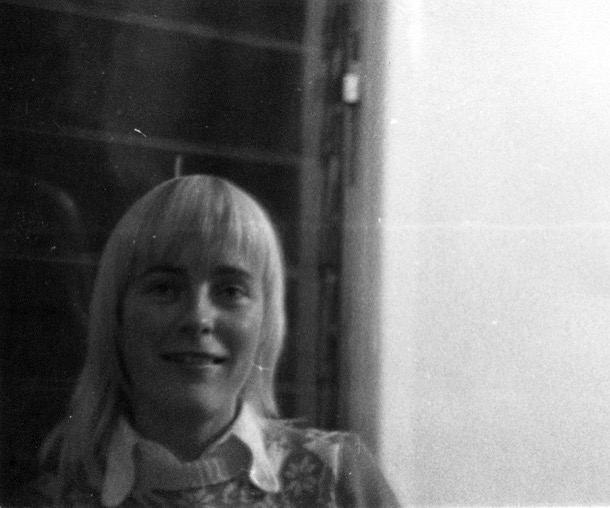
Rikki, 1968
That summer, after Christmas, we travelled up the Hume again, this time in Rikki’s little Volkswagen, “Greymouse”. Fred had spent his childhood living in Walwa, just over the NSW border, where his parents both worked at the Butter Factory. Family friends owned a farm that backed onto the Murray River near Corryong. Fred had spent childhood holidays exploring the river and knew of an island, reachable by car for most of the way, through the farm tracks. We lugged all our camping gear through the bush, waded over the river and set up on the island. I remember heat and flies, but also ants. We had a bush table on which the camp stove sat. Cooking required a tarp, on the ground in front of the table, wetted with river water, to keep the tiny ants from swarming up one’s legs.
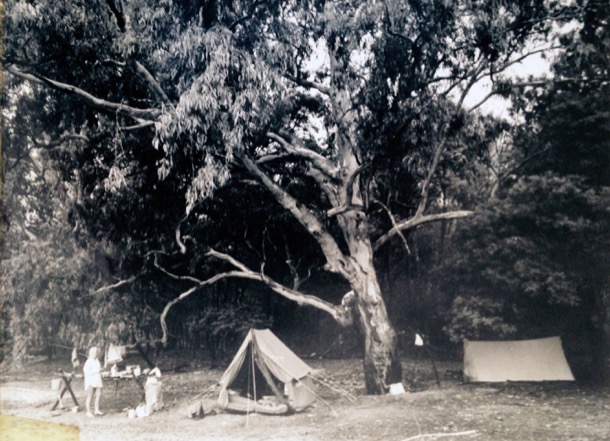
Camp on the island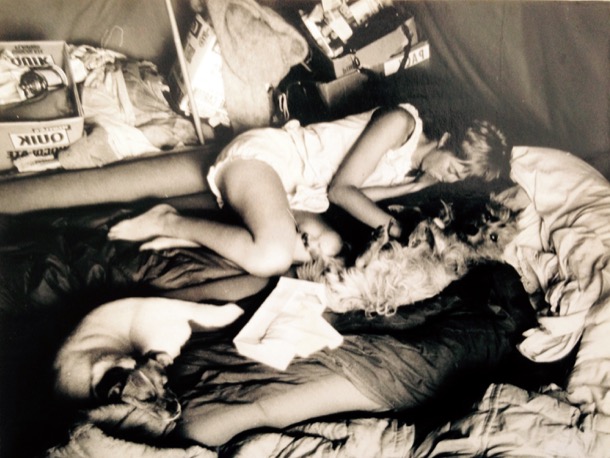
Inside the tent
Most of the time we were blissfully alone. However I remember lying naked in the river, hearing voices in the distance and being invaded by a scout troop on a canoeing expedition. I remember my acute embarrassment, lying in the all too shallow river. There was pointing and laughter from the scouts and unsympathetic mirth from my companions.
One night we drove to Corryong to have dinner. Afterwards, in the dark, perhaps a little drunk, we found out way back along the farm tracks, hiked through the bush and waded across the river back to our camp. We had torches, but in those pre LED days, torches were dim affairs which barely gave any light.
My exam results came out during that week and a simultaneous announcement of tertiary placements. This involved buying the Age newspaper and looking up your name. Once again we made the trek out to the car and drove to town. I was full of trepidation. How could such a distracted year and so little work end up with a place at Monash? Somehow it did. I was offered place in Monash Arts and a studentship.
Sue:
Our last trip together to the mountains was a year later, in January 1970. A very different experience but we followed our established pattern of the now many trips up here. We were on our way from Corryong to Khancoban all packed together in Rikki’s grey Beetle. In this small car we managed to pack four adults, two dogs, camping supplies and food. Unbelievable! It was very hot and the grass was straw coloured against a blue, blue sky when around the bend on the wrong side of the road came a car, driven by a worker from Snowy Hydro: a head-on in a rear-engined Volkswagen. We were very lucky.
Unhurt except for bumps on the head and a substantial coating of flour from an open packet in the food box we stumbled out of the car which was undrivable but only slightly damaged.
We did not get to the mountains, but we did get to stay with Elyne Mitchell at Towong Hill for two days, dogs and all. Mrs Mitchell happened to be driving past, saw the accident scene and took us in. With all our goods and chattels now in Mrs Mitchell’s Landcruiser, we drove back towards Corryong, but this time took the turn off to ‘Towong Hill’. We had so often passed the turn off, wondering about the house, hidden by large trees at the end of the small dirt road.
It was a marvellous experience, staying in that big old house, a large two story brick house, built in 1904, even though Mrs Mitchell was a slightly forbidding and austere presence.
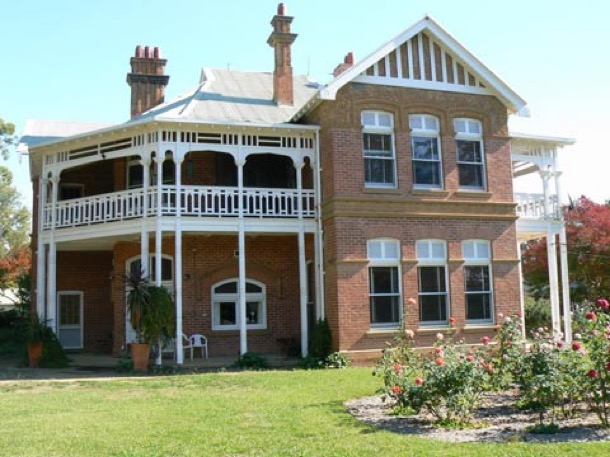
Towong Hill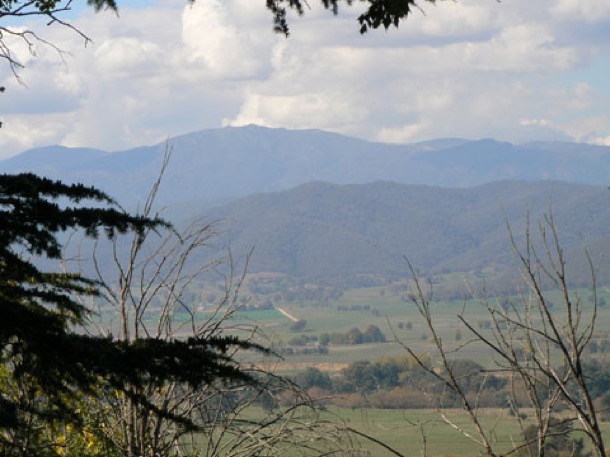
View from the house
We stayed upstairs in four of the many bedrooms. I remember white sheets and dark furniture and curtains blowing in the breeze. It was dark and cool downstairs, when we came down to breakfast the next morning. All the meals were served in the large formal dining room adjacent to a huge country kitchen. I remember Mrs Mitchell had biscuits, fresh tomatoes and herbs for lunch. No wonder she cut such a lean athletic figure.
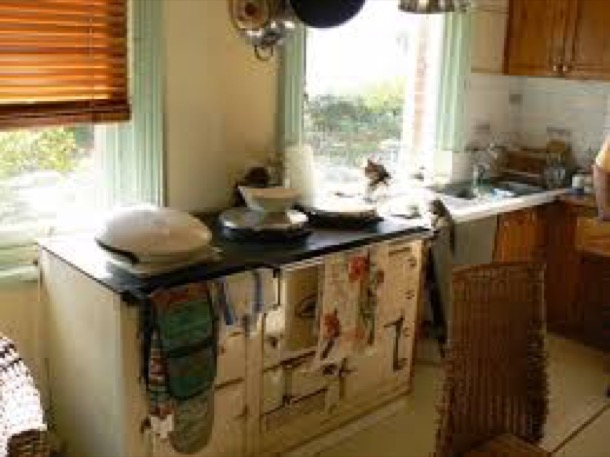
Towing Hill's kitchen
After we had been introduced to the many lovely farm dogs and seen the horses and stables, Mrs Mitchell suggested that a swim might be beneficial for our aches and pains. We drove down the hill to the river flats and the Mitchell's favourite swimming hole in a billabong of the Murray River. Bliss! It was still quite hot.
A last dinner in this world away and then the long drive back to reality. Fred’s brother Phillip was picking us up in the morning.
We did not realise at the time that we would not go to Albina Hut together again. Somehow that accident fractured the foursome but the friendships formed were to continue in a different forms for each of us.
